Welcome to Elk River Baseball
The ONLY local baseball organization supported, endorsed and integrated with the Elk River High School baseball coaches and players.
Elk River Youth Baseball 12671 Meadowvale Rd, Suite Q - Elk River, MN 55330
On a Mobile Device? Tap the Three Dashes to Navigate the Menus.

2025 Travel Tryout / House Evaluation Dates
2025 Travel Tryout and House Evaluations Dates
Saturday March 29 and Sunday March 30
Mark your calendars!!!!
Travel players MUST attend both days!
House players are Highly Recommended to attend.
2024 Dates To Remember
We are looking for umpires.
Interested in Umping this season?
We are looking for kids 12 years and older.
Gail Hensler [email protected] 612.720.1822
WE NEED NEW BOARD MEMBERS!
Elk River Youth Baseball is looking for people who are interested in shaping the future of Elk River Youth Baseball.
If you are interested, please fill out the application below and email to the president or any board member.
Board Member Application
House league breakdown.
The Elk River Youth Baseball redeveloped our house leagues for kids 4th grade and younger in 2021. These changes allowed for kids to be divided into leagues based on ability and age, so they can continue to develop as young athletes.
Our leagues follow the guidelines below:
- Minors (Coach Pitch) – Prek – 1st Grade, this is an introductory coach pitch league.
- National League (Beginner Kid Pitch) 1st – 3rd Grade. This is an introductory modified kid pitch league, where kids are introduced to pitching.
- American League (Advanced Kid Pitch) 2nd – 4th Grade. This is an advanced kid pitch league that allows kids to improve their skills in all aspects of the game.
Each league is a progression, to help kids move up and be prepared for competitive and/or travel baseball.
Kids from PreK – K will start in our Minors Coach Pitch League.
1st Graders have the option to play coach pitch or our modified kid pitch league if they are ready.
2-4th Graders can register for either house or travel. These kids will be evaluated during our tryout weekend. Kids who opt to play house, and kids trying out for travel that do not make a team, will be placed in either our National (beginner kid pitch) or American (advanced kid pitch) league based on their evaluation scores.
Indoor Training Facility Rental
Are you looking to get a few more cuts off a tee? Would you like to take some swings at balls from our pitching machine? Maybe you want to work on some fielding and throwing. You can rent time in our indoor training facility. Please read through the baseball facility policies to understand all the rules and regulations to be followed. We have 2 batting cages for hitting and a wide turf area to work on fielding, throwing, etc. If you are interested in renting time in our facility, email Dave Lodermeier to schedule your time in the facility.
Indoor Facility Policies
Indoor facility waiver form, equipment help.
With baseball season right around the corner, you might have questions about what equipment you need to have for your child to be ready to play.
Check out out new Equipment Page for some help deciding what to buy!

Thank you for sponsoring Elk River Youth Baseball
Join our website.
Looking to become a member of Elk River Baseball? Click the link below to get started!
Become a Member
*You can also find this link under the 'About Us' tab along with other useful information.

Thank You to Franklin Outdoor Advertising for Your Continued Support of Elk River Baseball!

Thank You to Morrell Transfer for Your Continued Support of Elk River Baseball.
This season Elk River Youth Baseball will be raising money to help with some field improvements. Your donation of any denomination will help us achieve this effort. See our Fundraising link for more information.
Would you like to make a donation?
If you are interested in making a donation, please do so through Venmo or contact a board member.


6th Annual Battle on the Border
06/06 to 06/08/2025
Youngstown, OH
Tournament Info
The Battle on the Border hosted by AC Baseball is a 4 game guarantee tournament taking place in both Ohio and Pennsylvania. This is the 6th year of one of our favorite events. Each year, over 110 teams play on some of the best youth baseball fields both OH and PA have to offer. The event features teams from all over the states of Ohio, Pennsylvania, West Virginia, Virginia, Maryland, New York and more! Teams will generally play 3 Pool-Play games before advancing to Bracket Play.
The Fields of Dreams (Boardman, OH) and Next Level Sports Complex (New Waterford, OH) will feature the 09U-14U age divisions. 8U KP will be played at Three Rivers Sports Complex (McKees Rocks, PA) The 15U-18U teams will be playing in the Monroeville / Pittsburgh area.
Quick Tournament Facts
- 2023 featured over 155 teams from 6 states and Canada
- Baseballs: 3 new baseballs will be provided to the umpires before each game
- 4 Game Guarantee
- 8UKP & CP – Three Rivers Sports Complex, Mckees Rocks, PA
- 09U-14U Boardman, OH
- 15U-18U Pittsburgh, PA
- Please review the tournament rules prior to the event
- Coaches will be able to nominate players for the All Star Game throughout the weekend.
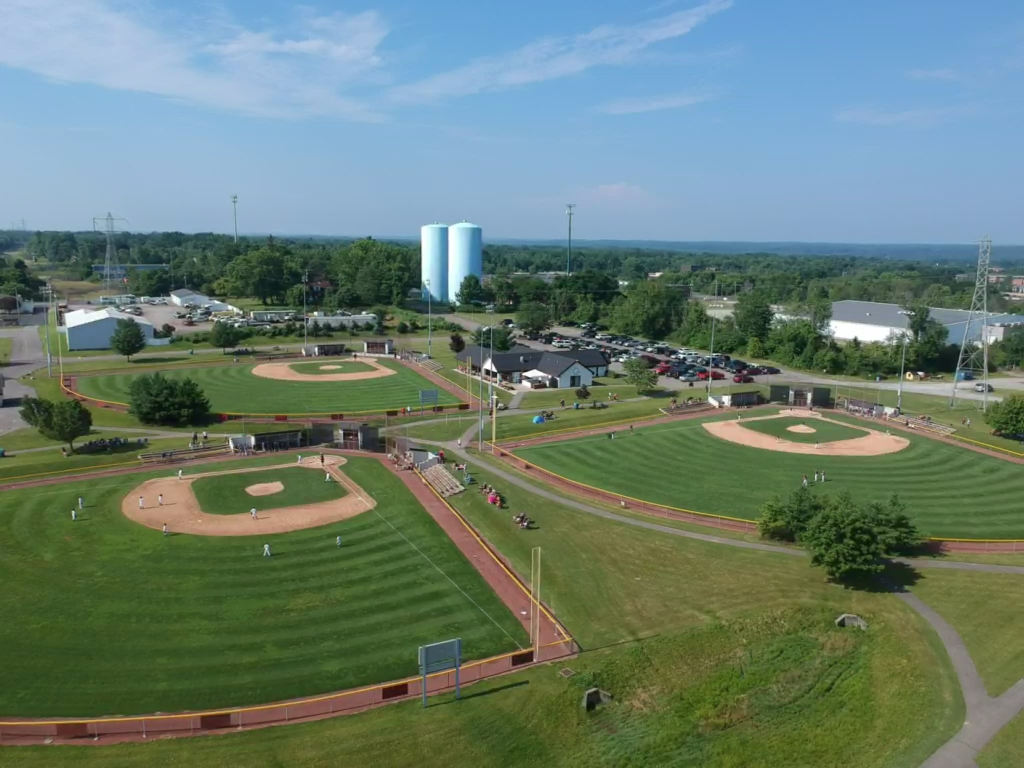
Youngstown Baseball Tournaments
Check out our schedule of 2022 Youngstown baseball tournaments. AC Baseball hosts the best competition for youth and high school Youngstown baseball players, colleges and stadium facilities. Located in Pittsburgh, we have events all over the United States. If you would like to be a host site for one of our AC Sports Youngstown baseball tournaments please contact us .
FACILTY DETAILS
08U-14U Boardman, Oh 410 McClurg Road Youngstown, OH
15U-18U Pittsburgh, Pa 4000 Mosside Blvd Monroeville, PA
3 Rivers Field Complex 133 Ewing Rd Mckees Rocks, PA
Ace of Diamonds Sports Complex 2112 Waterford Road New Waterford, OH
Armstrong High School 300 Buffington Dr Kittanning, PA
Field of Dreams 410 McClurg Road Youngstown, OH
Gateway HS 9000 Campus Blvd Monroeville, PA
Gateway Middle School 4450 Old William Penn Hwy Monroeville, PA
KOCH Fields 650 N. Raccoon Road Youngstown, OH
La Roche University 1302 Duncan Ave Pittsburgh, PA
Latrobe High School 131 High School Road Latrobe, PA
Plum High School 900 Elicker Road Pittsburgh, PA
Pullman Park 101 Pullman Park Place Butler, PA
Seton Hill University 1 Seton Hill Dr Greensburg, PA
West Field Complex 1900 West Street Munhall, PA
Woodland Hills HS 2550 Greensburg Pike Pittsburgh, PA

- Visit Our Blog about Russia to know more about Russian sights, history
- Check out our Russian cities and regions guides
- Follow us on Twitter and Facebook to better understand Russia
- Info about getting Russian visa , the main airports , how to rent an apartment
- Our Expert answers your questions about Russia, some tips about sending flowers

Russian regions
- Amur oblast
- Buryat republic
- Chukotka okrug
- Jewish autonomous oblast
- Kamchatka krai
- Khabarovsk krai
- Magadan oblast
- Primorye krai
- Sakha republic
- Sakhalin oblast
- Zabaikalsky krai
- Map of Russia
- All cities and regions
- Blog about Russia
- News from Russia
- How to get a visa
- Flights to Russia
- Russian hotels
- Renting apartments
- Russian currency
- FIFA World Cup 2018
- Submit an article
- Flowers to Russia
- Ask our Expert
Amur Oblast, Russia
The capital city of Amur oblast: Blagoveschensk .
Amur Oblast - Overview
Amur Oblast (also known as Amurskaya , Priamurye , Priamurie ) is a federal subject of Russia located on the banks of the Amur and Zeya rivers, about 7,700 km east of Moscow, in the Far Eastern Federal District. Blagoveshchensk is the capital city of Amur Oblast.
The population of Amur Oblast is about 772,500 (2022), the area - 361,913 sq. km.
Amur oblast flag
Amur oblast coat of arms.
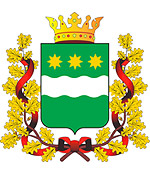
Amur oblast map, Russia
Amur oblast latest news and posts from our blog:.
14 February, 2017 / Blagoveshchensk - the view from above .
28 May, 2015 / Construction of the cosmodrome "Vostochny" .
3 July, 2014 / The construction site of the new Russian cosmodrome "Vostochny" .

News, notes and thoughts:
28 April, 2016 / April 28, 2016, the first historic launch of the space rocket was carried out from the new Russian cosmodrome "Vostochny" located in the Amur region in the Far East. The carrier rocket "Soyuz 2.1a" successfully launched three satellites into orbit.
History of Amur Oblast
The first Russian settlers came to the Amur region in the middle of the 17th century. However, they encountered resistance from the local population that turned to the Manchus for protection. In 1689, in accordance with the Treaty of Nerchinsk, Russia lost Priamurye.
In the 19th century, Manchu China weakened and, by Aigun Treaty (1858), Priamurye once again came under the rule of Russia. In 1860, the treaty was confirmed and significantly expanded in the Beijing Treaty. In Chinese historiography, both treaties are considered unequal as China, weakened by the Opium wars and the Taiping Rebellion, was forced to make territorial concessions.
A lot of people arrived to the Amur region with the construction of the Trans-Siberian Railway. By the end of the 1930s, the population of the Amur region increased by half compared to pre-revolutionary times and amounted about 450,000 people.
In 1958, the population of Amur Oblast reached 717,500. The main causes of rapid population growth were the development of virgin land, the construction of the Zeya and Bureya hydroelectric power stations, the Baikal-Amur Mainline, increase in the number of armed forces and border troops.
Pristine nature of Amur Oblast
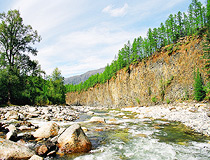
Mountain river in Amur Oblast
Author: Sveshnikov Alexander
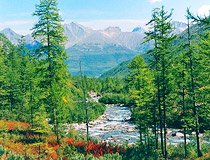
Nature of Amur Oblast
Author: Sergey Bulanov
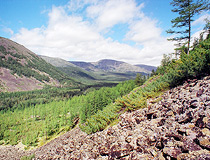
Amur Oblast landscape
Amur Oblast - Features
Most of the region is located in the basin of the Upper and Middle Amur - hence the name of the region. South-eastern boundary of the Amur region is the state border of the Russian Federation and is bordered by the People’s Republic of China.
The Stanovoy Range divides Amur Oblast and the Republic of Sakha (Yakutia). The higher elevations of mountains are overgrown with dwarf Siberian pine and alpine tundra. Larch and pine forests grow along the river plains. Also, the Zeya River originates in these mountains.
There is a dam built in the middle of the Zeya River creating Zeysky water reservoir. Also there are mountains separating the region from Khabarovsk krai in the east with larch and fir-spruce forests. The Amur, Bureya and Zeya rivers form a place of highest biodiversity in the region.
The climate is transitional from the harsh continental in the north-west to monsoon in the south-east.
The fauna of the Amur region is rich and varied. The most widely known animals are the Amur leopard and the Amur tiger, which unfortunately are on the verge of extinction.
Amur Oblast - Economy
The main railroads are the Trans-Siberian Railway and the Baikal-Amur Railway. The region has such natural resources as gold, iron, non-ferrous and rare metals, coal, precious, half-precious stones, different construction materials, fresh and mineral water.
Soils are fertile enough for productive agriculture. There are reliable sources of power in Amur Oblast, including power stations consuming local coal as well as Zeyskaya and Bureyskaya hydro-power stations.
The main local industries are power engineering, mining (gold, coal), timber, wood processing, building materials production, food processing. Agricultural lands occupy about 1,000,000 hectares. The leading branches of agriculture are crops and soya beans growing, meat-and-milk production, in the north of the region - reindeer breeding, in south-east and partly in middle of the region - beekeeping.
In 2012, construction of the cosmodrome (spaceport) Vostochny (Eastern) began on the territory of Amur Oblast. It is located near the newly built town of Tsiolkovsky, 45 km north of Svobodny city. It is the first Russian civilian spaceport.
In October 2015, 14 km from Svobodny, construction of the Amur gas processing plant began - the largest in Russia and one of the largest in the world.
Amur oblast of Russia photos
Landscapes of amur oblast.
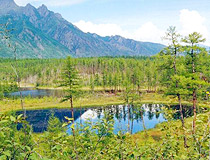
Amur Oblast scenery
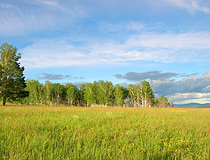
Amur region scenery
Author: Tarnovsky Roman
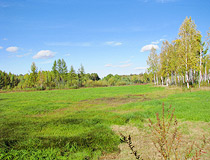
Amurskaya Oblast nature
Author: Evgeny Lopatin
Pictures of Amur Oblast
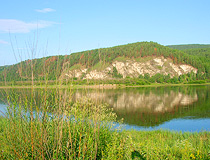
River ferry in Amur Oblast
Author: Roman Aksenov
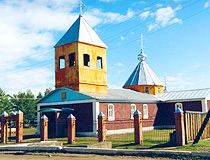
Church in Amur Oblast
The comments of our visitors
I agree it is a very beautiful region and I feel people don't know enough about these lovely places and what a beautiful land that Russia is. I have always had a love of Russia and particularly this region, and as one of my favourite animals is the tiger, I am concerned that these beautiful creatures could soon be extinct (I would love to adopt one!).
We live in a great world, when you think a lot of it is still unexplored, that we should appreciate it more ("dress it and keep it" Scripture) there wouldn't be all this exploitation and our wildlife would be protected from harm. If we don't wise up, we will no longer have any wildlife to enjoy, and future generations will be missing out.
- Currently 2.75/5
Rating: 2.8 /5 (175 votes cast)
Sponsored Links:
- Bahasa Indonesia
- Slovenščina
- Science & Tech
- Russian Kitchen
Blagoveshchensk: Russia's anchor on the Amur River
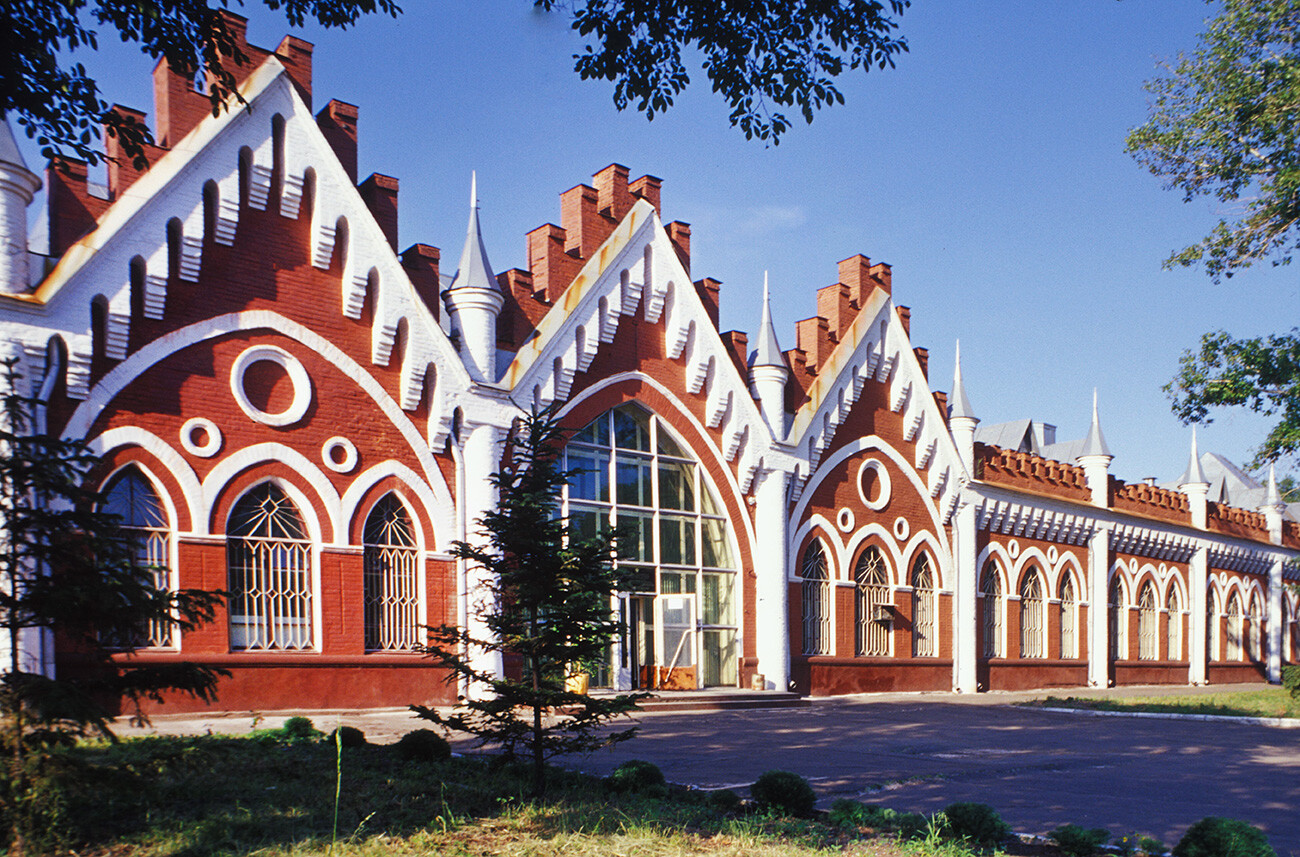
Blagoveshchensk. "Mauritania" Trading Rows. Built in 1907 in a Gothic Revival style near the Amur River waterfront. June 16, 2002
At the beginning of the 20th century, Russian chemist and photographer Sergey Prokudin-Gorsky developed a complex process for vivid, detailed color photography.
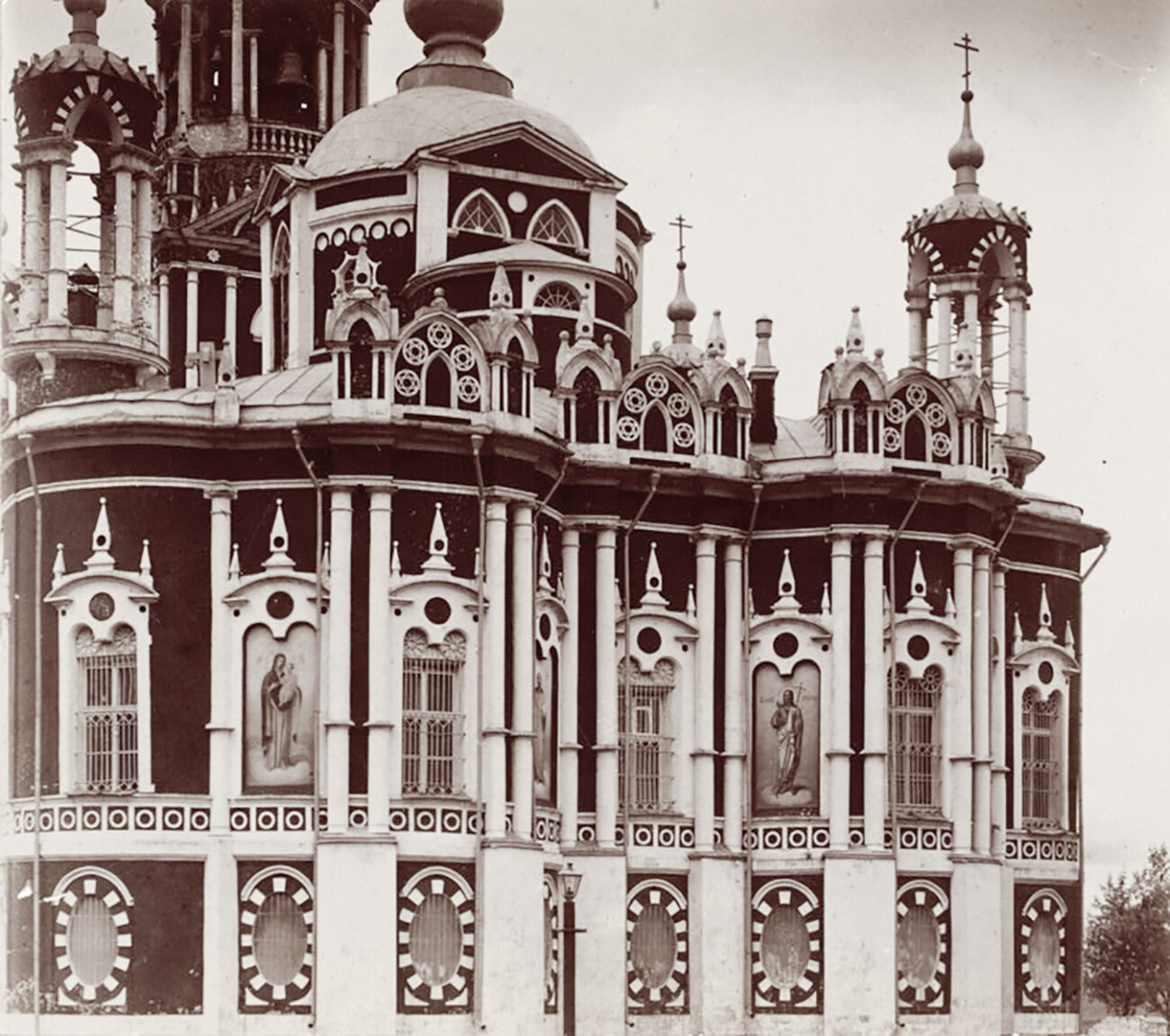
Mozhaisk. Cathedral of St. Nicholas. East facade with Gothic Revival decoration. Summer 1911
His vision of photography as a form of education and enlightenment was demonstrated with special clarity through his photographs of architectural monuments throughout the Russian heartland.
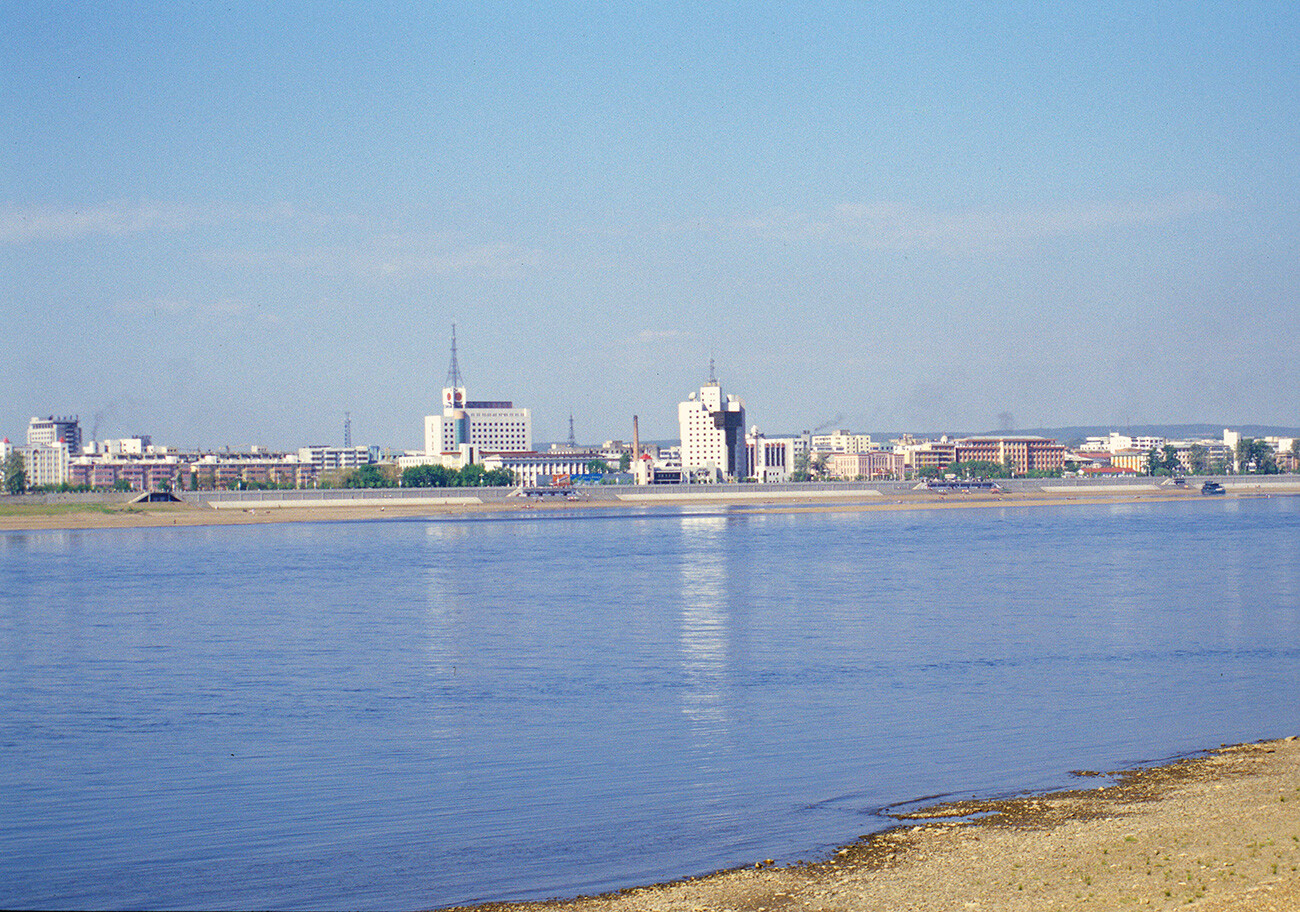
Blagoveshchensk. View across Amur River toward Chinese city of Heihe. June 15, 2002
St. Nicholas Cathedral in Mozhaisk
An excellent example is the small town of Mozhaisk, which Prokudin-Gorsky visited in the Summer of 1911 as part of a project to document sites connected with the centennial of the Napoleonic invasion of Russia.
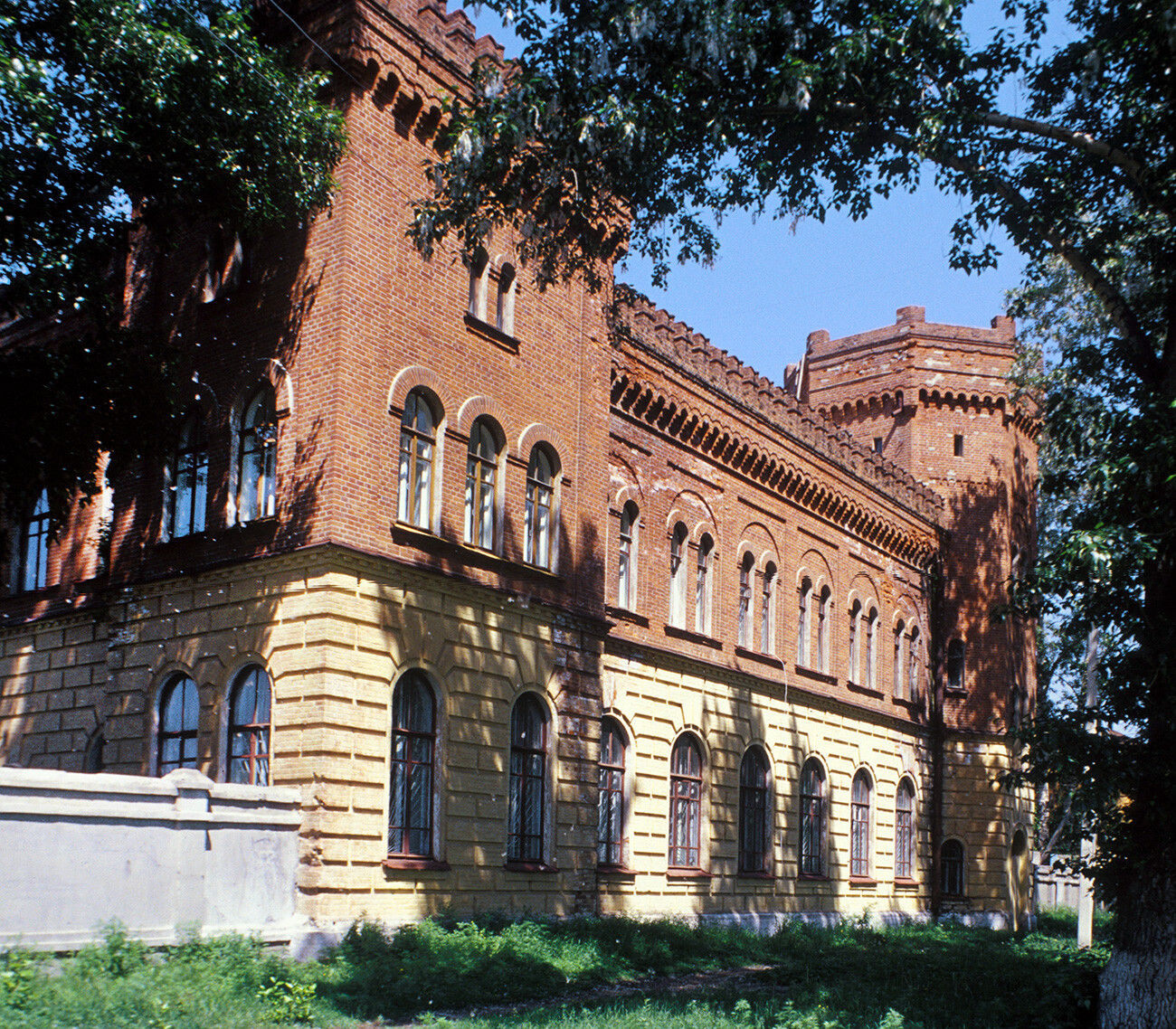
Blagoveshchensk. Headquarters of Amur Society for Shipping & Trade (1910-12). June 13, 2002
He was particularly taken by the festively decorated St. Nicholas Cathedral , located at the town’s highest point (the former Mozhaisk Kremlin).
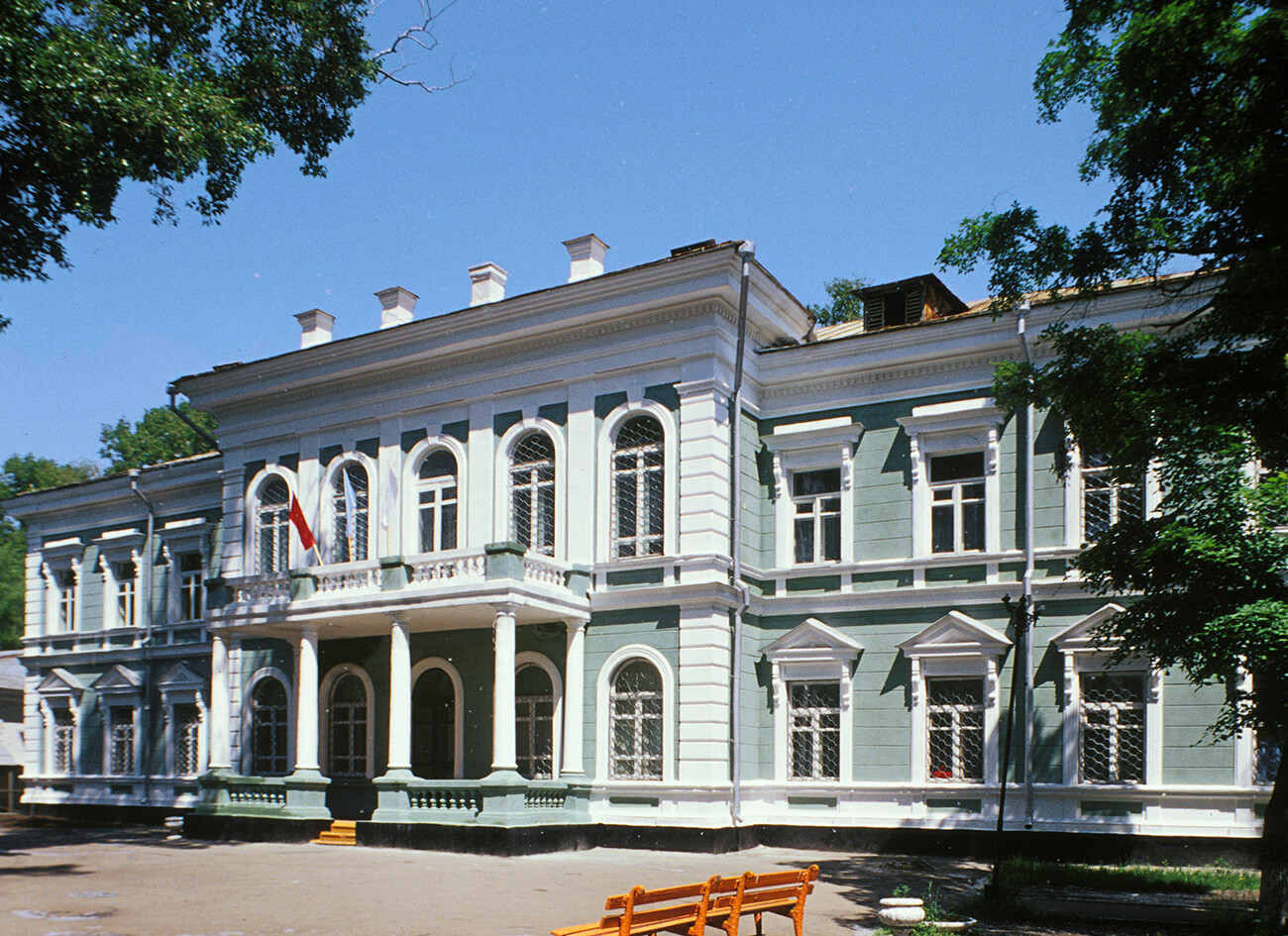
Former Residence of Military Governor, Lenin Street 144. Built in 1909-12. Now House of Culture. June 13, 2002
Construction of a new St. Nicholas Cathedral began in the late 18th century and culminated in the early 19th century in an exuberant Gothic Revival style patronized by Catherine the Great in the late 18th century.
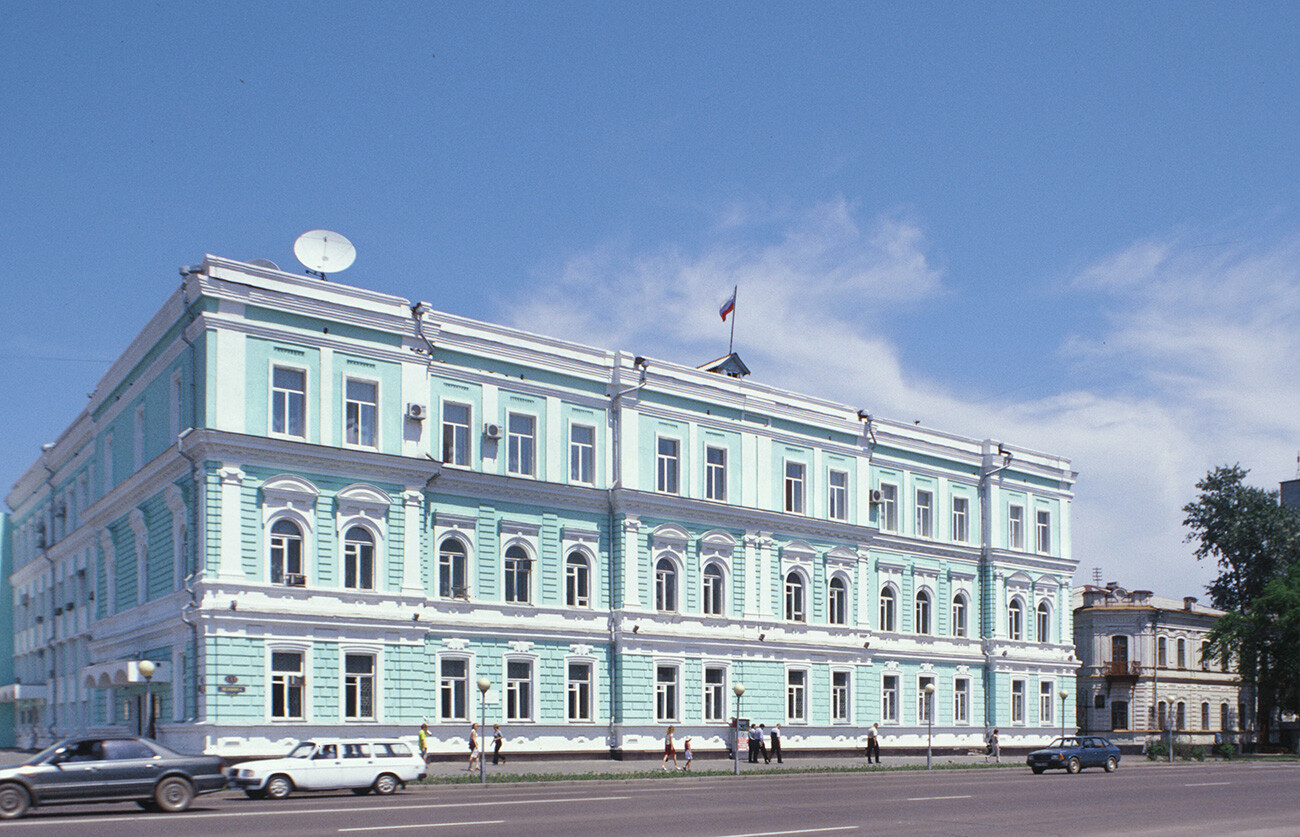
City Hall, Lenin Street 133. In its core, the building was originally a mansion built in 1890s for the gold trader Gleb Larin. During post-war expansion, the building doubled in length and gained a third floor. June 14, 2002
Tellingly, the Mozhaisk cathedral was designed by Aleksey Bakarev, a pupil of renowned architect Matvey Kazakov, who built much of the Gothic Revival fantasy at Catherine’s imperial Tsaritsyno estate near Moscow.

"Topaz" Flour Mill, built in 1899-1900 by the brothers Naum & Micah Sayapin, members of the local Molokan community. June 13, 2002
Gothic Revival reaches the Far East
Although the Gothic Revival style waned in the middle of the 19th century, it never disappeared and was often applied in the design of mansions for wealthy entrepreneurs, especially in the Moscow area.
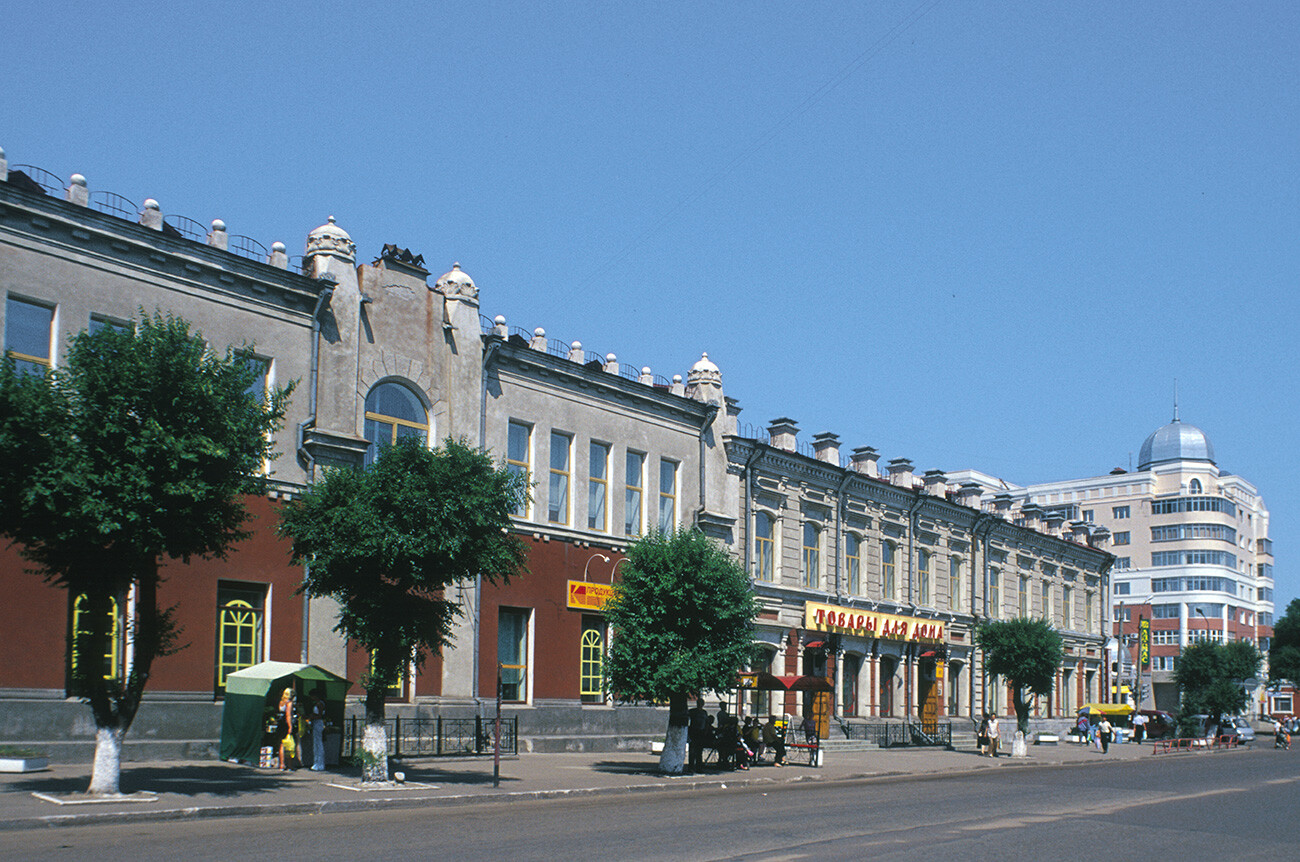
Amur Street. Left: former Ivan Churin & Co. Department Store No. 2 (Amur Street 199), built in 1899, expanded 1910. Right: Platonov Brothers Store (Amur Street 197), built in 1900 for brothers Mikhail & Stepan Platonov, leading supporters of the local Molokan community. June 15, 2002
Indeed, the enduring appeal of the Gothic Revival spread to the distant reaches of the empire, exemplified by the brightly painted ‘Mauritania’ Trading Rows in the center of distant Blagoveshchensk, on the Amur River almost 8,000 km east of Moscow.
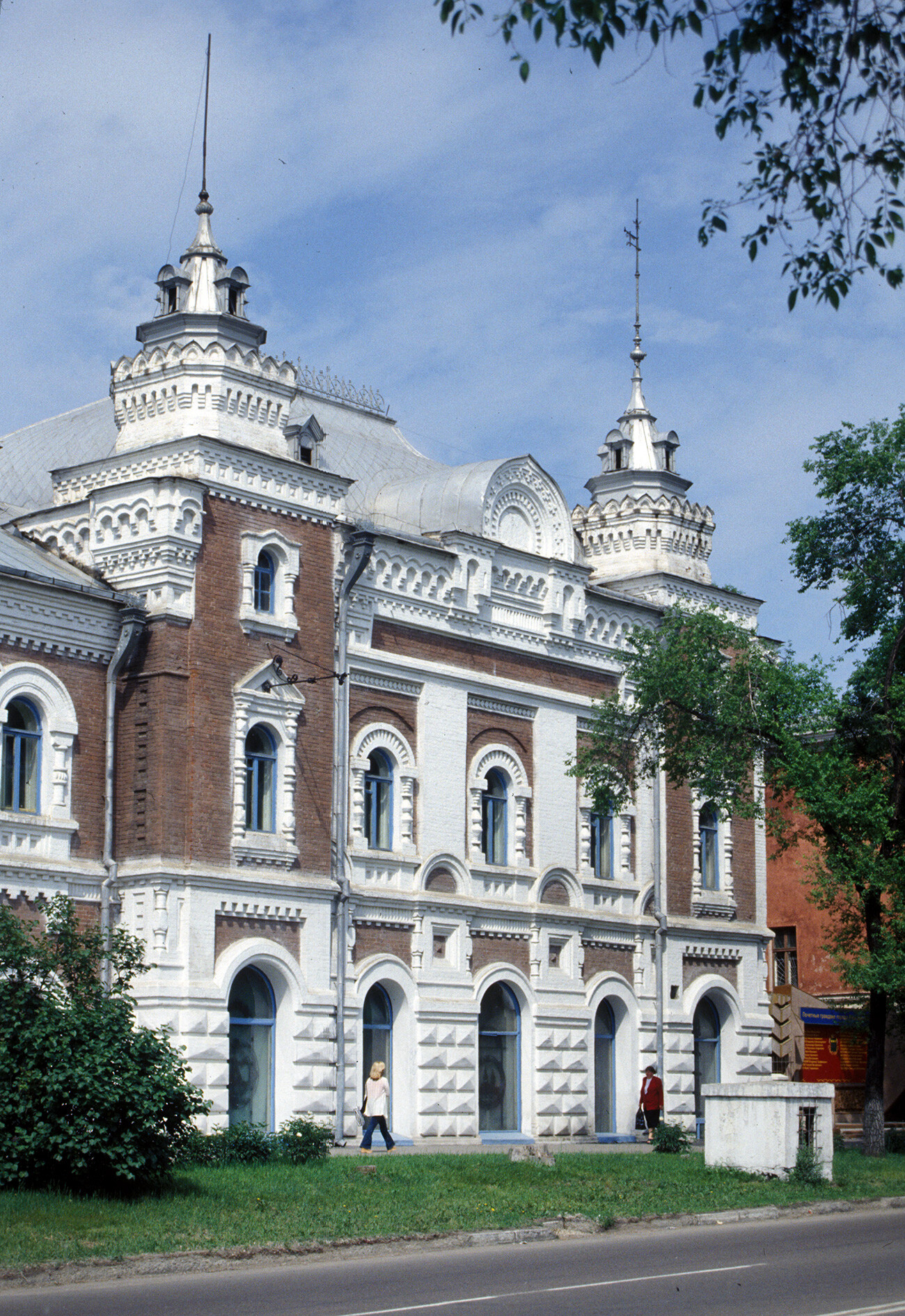
Former Kunst and Albers Department Store (1894), Lenin Street 165, main entrance. Now Amur Regional History Museum. June 13, 2002
Blagoveshchensk-on-Amur is not one of the more notable destinations in the Russian Far East. That status belongs to Khabarovsk and Vladivostok. Nonetheless, Blagoveshchensk has, since the 1850s, anchored Russia's critical southern boundary with Manchuria along the Amur, whose Chinese name is ‘Heilongjiang’ (‘Black Dragon River’).
Clashes with the Chinese
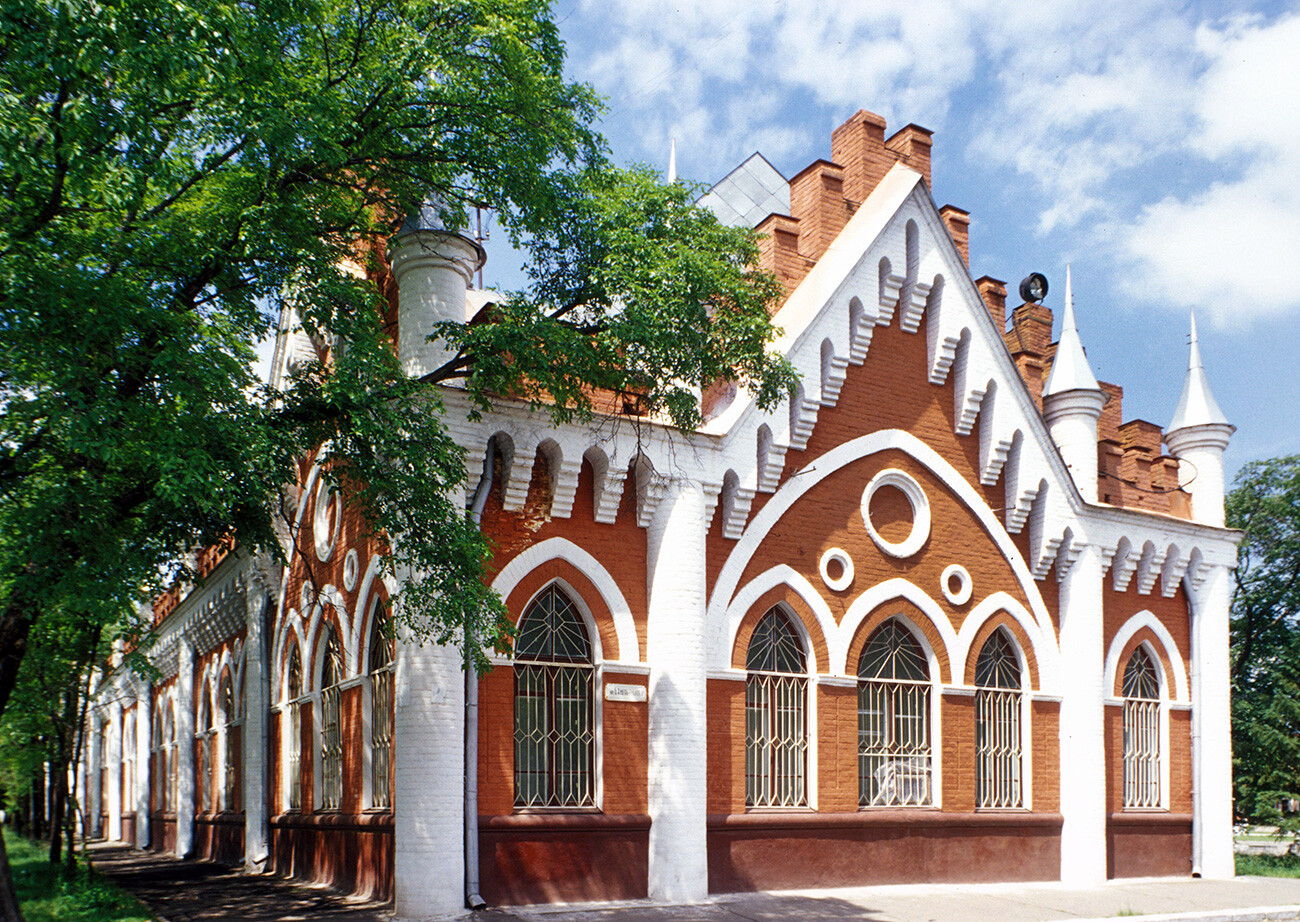
"Mauritania" Trading Rows (1907). Side view with Gothic Revival decorative detailing. June 13, 2002
Russian Cossacks and explorers had attempted to gain control of the north (left) bank for the Amur as early as the 1640s. Yet, following the prolonged siege by Manchu forces of the Russian Albazin fort on the Amur in 1685-1686, Russia was compelled by the Treaty of Nerchinsk (1689) to abandon the area north of the Amur and retreat west beyond the Argun River, which merges with the Shilka to form the Amur.
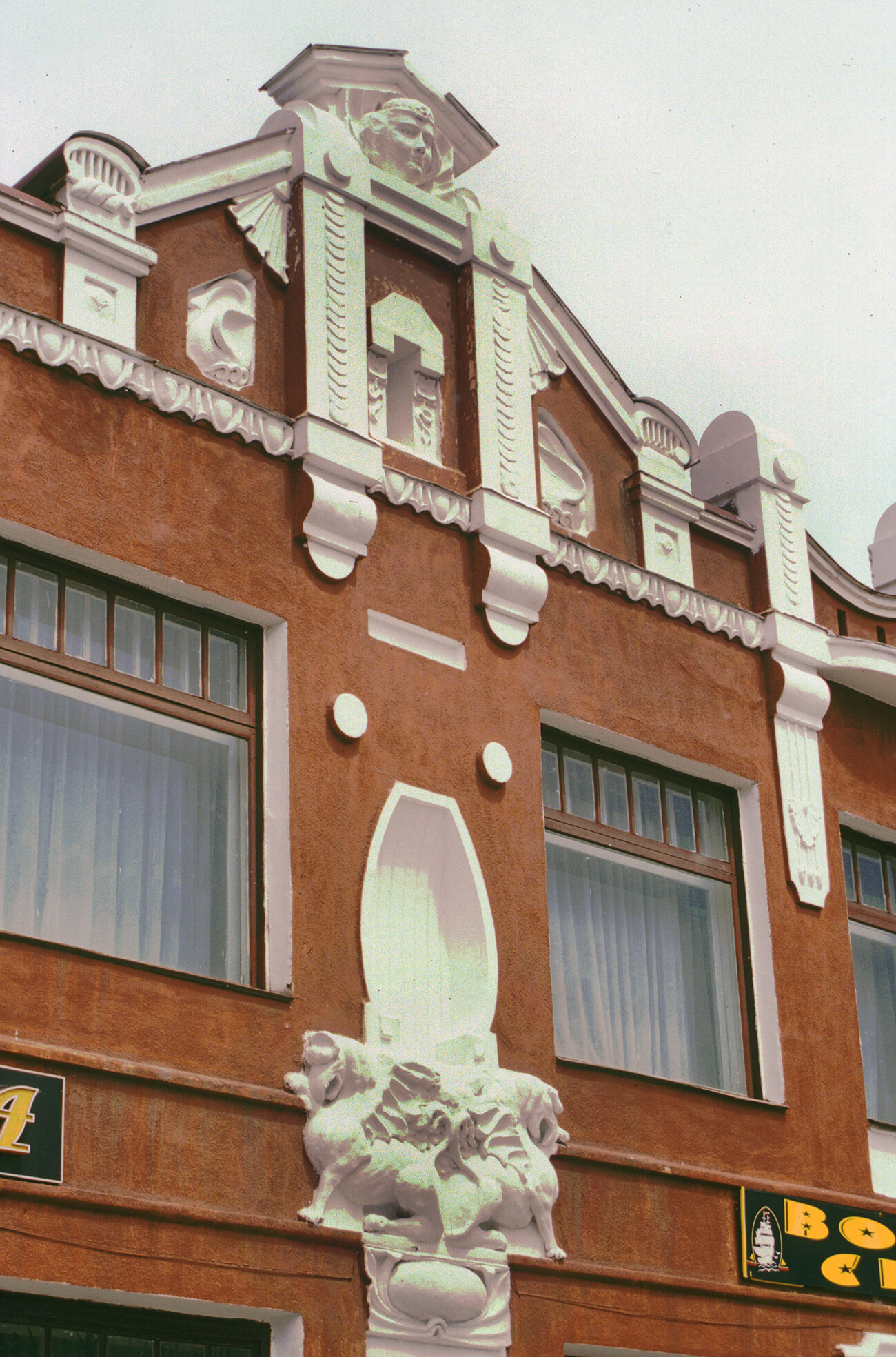
A. A. Urmancheev & Sons Department Store (1911-12), Lenin Street 157. Upper part of central facade with Art Nouveau decoration. June 13, 2002
Not until the mid-19th century did substantial Russian forces return to occupy the territory under the leadership of Governor-General Nikolai Muravyov, subsequently given the title ‘Amursky’ for his role in acquisition of the territory for the Russian Empire. China, weakened by the Taiping Rebellion and the Second Opium War, was compelled to recognize the Russian presence by the Treaty of Aigun (1858), which ceded to Russia vast arable lands north of the Amur.
Birth of Blagoveshchensk
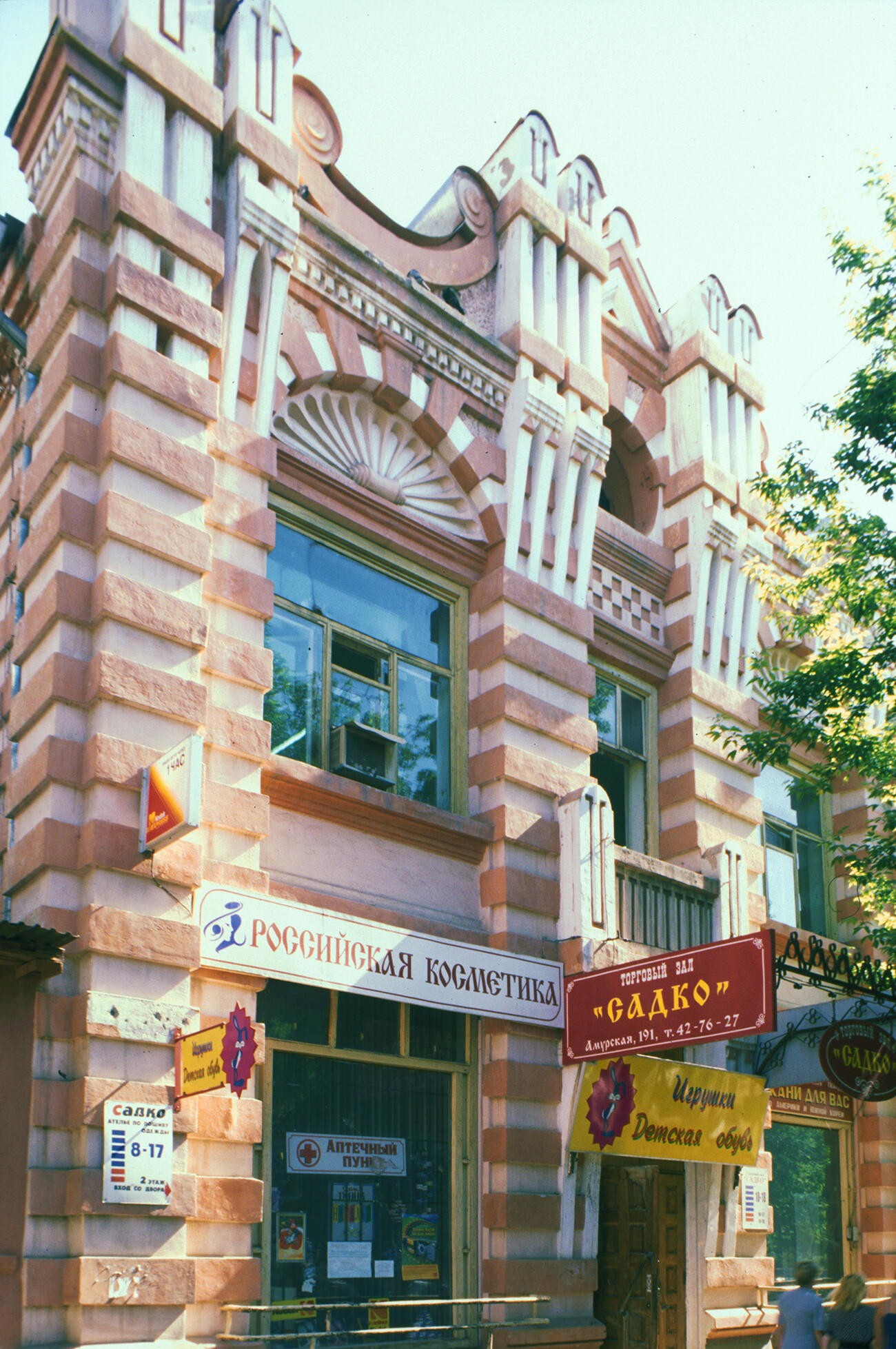
F. F. Korotaev Store, Amur Street 191. Built at beginning of 20th century in an extravagant form of Style Moderne. June 14, 2002
The town of Blagoveshchensk (from the Russian word for Annunciation) was founded that same year near the point where the Zeya River empties into the Amur. Its population expanded gradually, largely on the basis of active trade and transportation along the Amur and its western tributaries in Russia. By 1897, the town had 33,000 inhabitants, as well as a substantial Chinese community. In the Summer of 1900, the town was shelled by Chinese insurgents across the Amur River during the Boxer Rebellion. Fearing an internal threat, Russian authorities expelled the Chinese inhabitants of Blagoveshchensk.
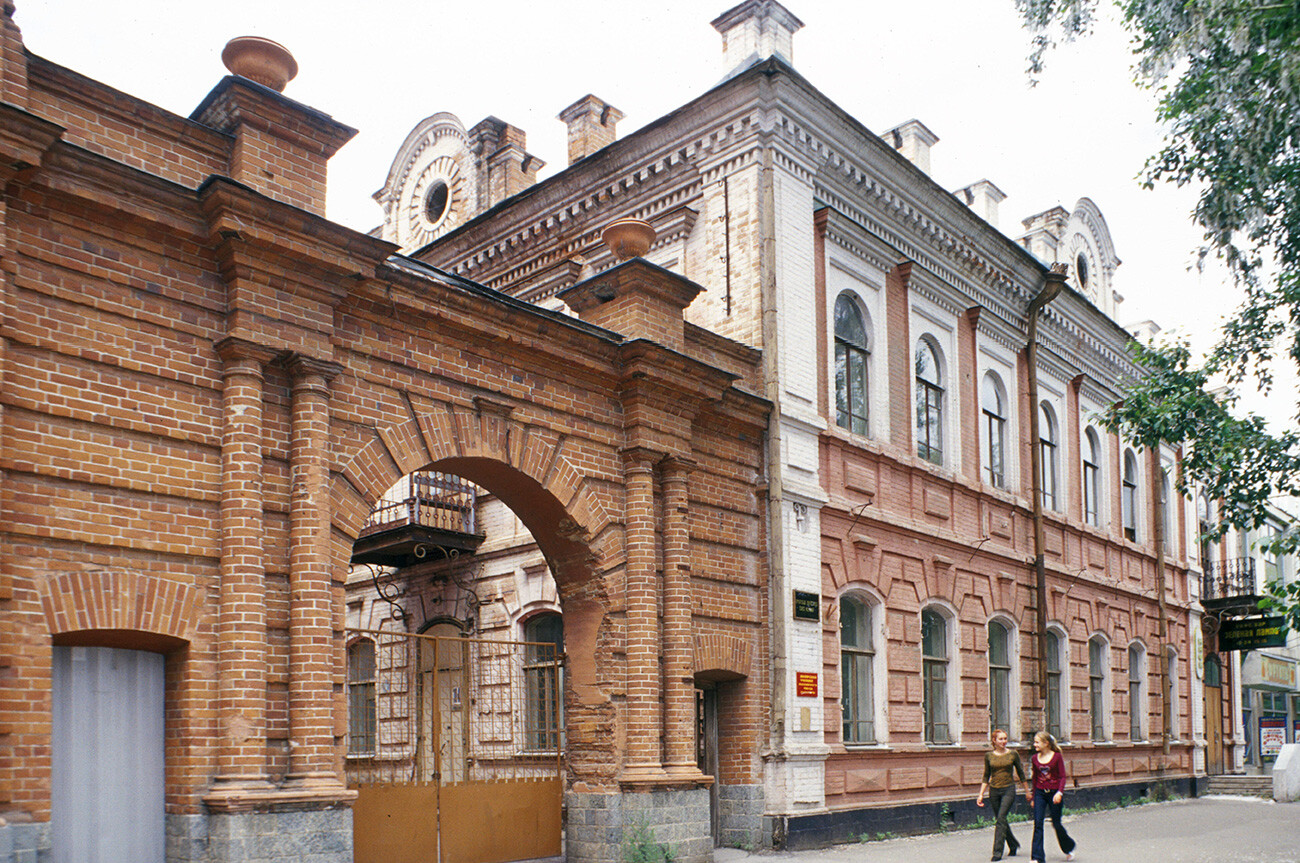
N. V. Kositsyn & Sons Store, Pioneer Street 26. Built in 1912 for yet another Molokan merchant. June 13, 2002
Although not situated on the Trans-Siberian Railroad (a 110-km spur from the main line was completed only in 1915), Blagoveshchensk flourished in the early 20th century, not only through trade, but also by virtue of the surrounding fertile agricultural land and the presence of gold deposits, which created a local gold rush (the gold assayer's building still stands in the center of town).
Bustling trading outpost
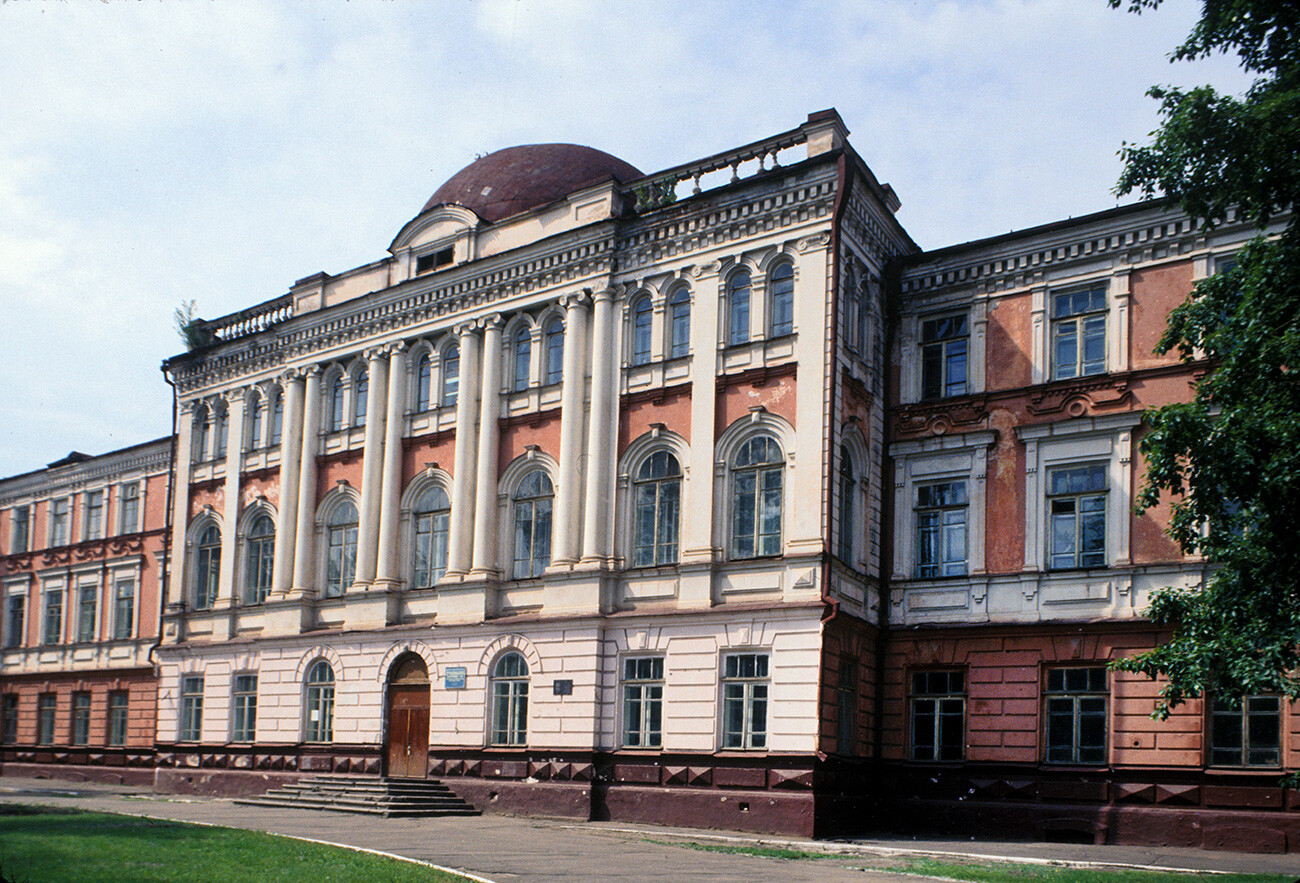
Alekseev Women's High School. Founded in 1902 and built in 1910-11. June 13, 2002
The town’s prosperity was reflected in imposing commercial buildings that survive to this day, including department stores, trading centers and flour mills. The most colorful of these structures is the ‘Mauritania’ Trading Rows, erected in 1907 on the Amur River bank. The adjacent city dock received steamboat deliveries of flour, meat, fruits and vegetables that would be processed and sold by shopkeepers in the Trading Rows.
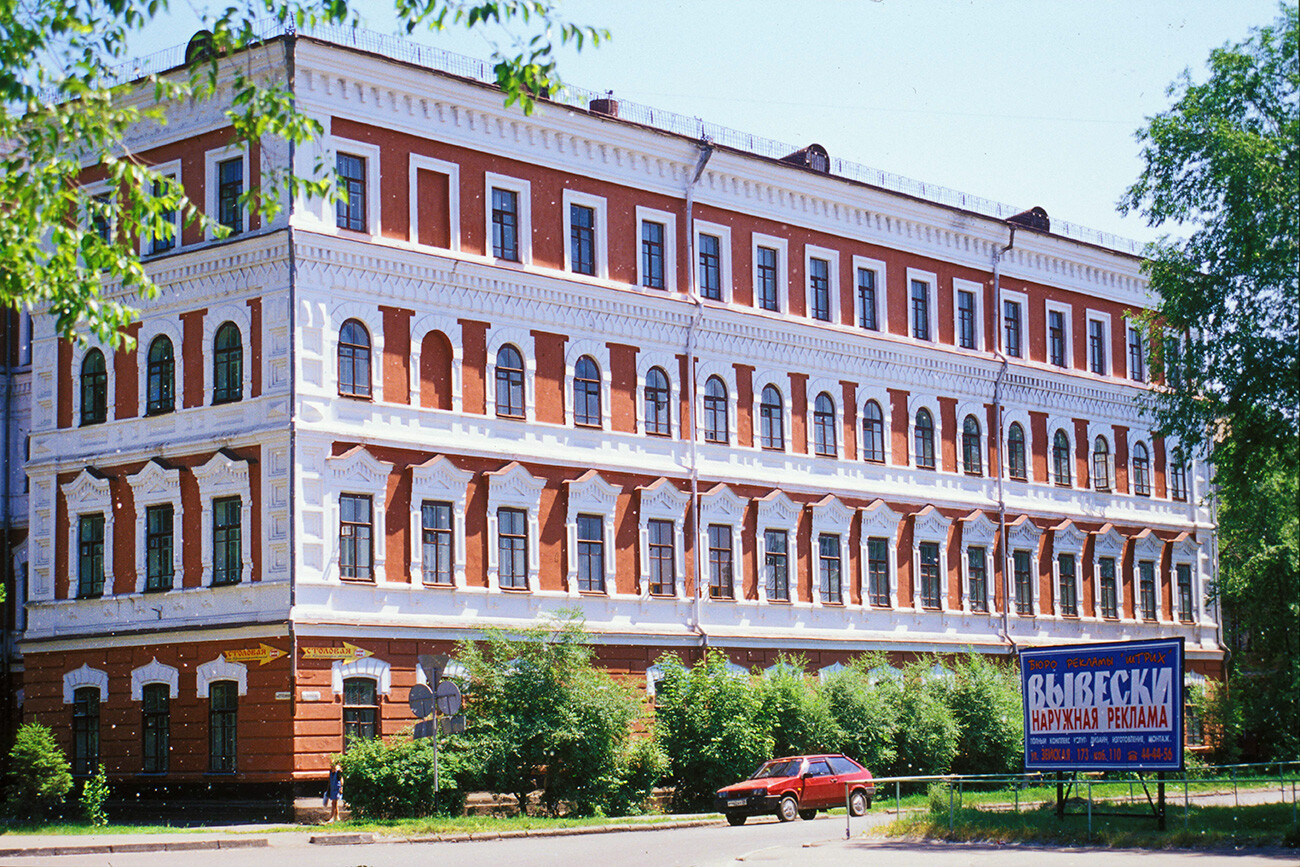
Men's High School, Lenin Street 104. Built in 1909-12; fourth floor added during reconstruction after fire in 1960. June 15, 2002
It should be noted that Blagoveshchensk also had an American commercial presence, reflected in the “American Lane” in the central commercial district. The primary focus of these enterprises was agricultural equipment for the rapidly expanding grain fields.
20th-century boom & multiple wars
During its early 20th-century construction boom, Blagoveshchensk built educational institutions – for women, as well as men – whose size would rival those of American cities. An especially imposing example is the Women’s High School.
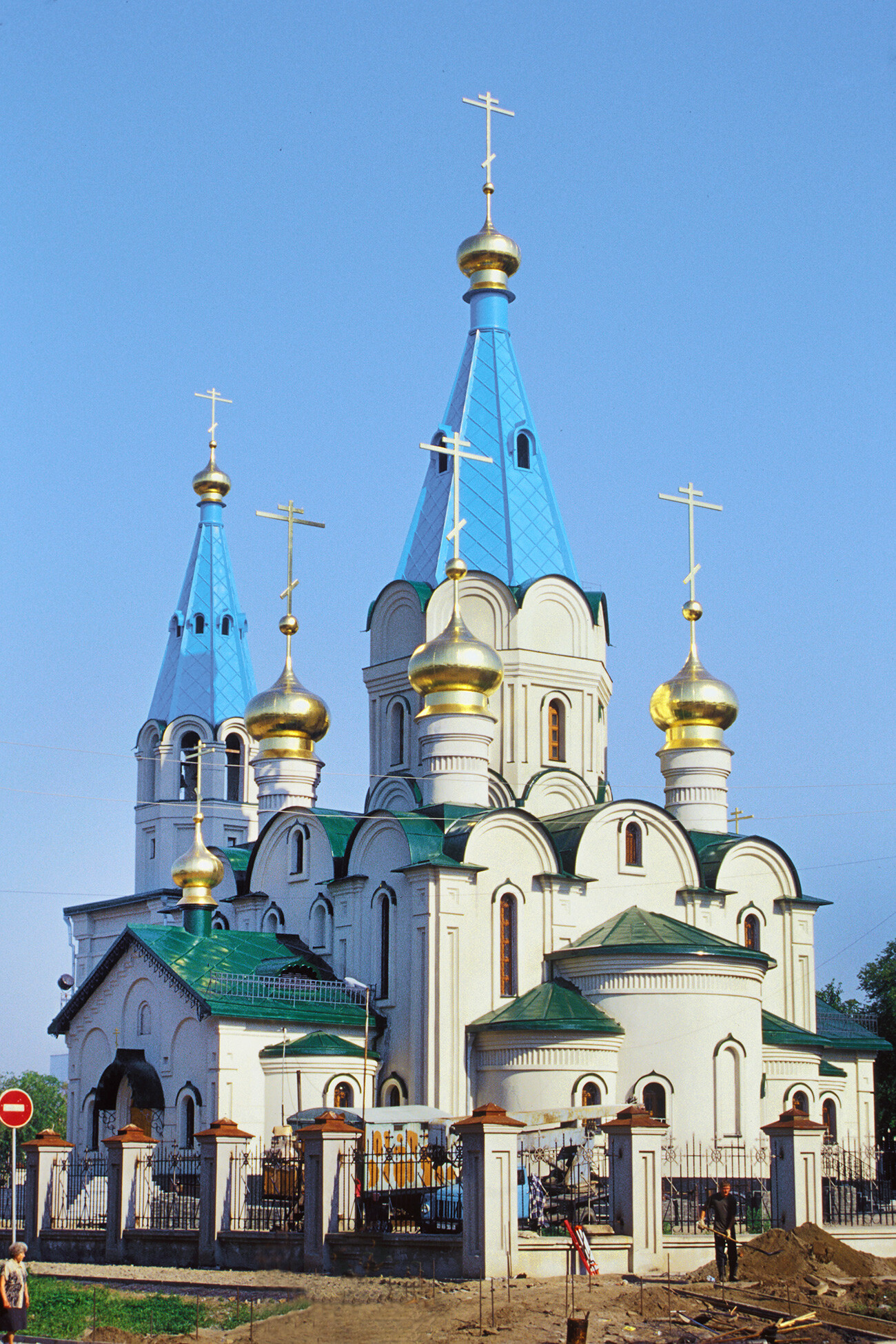
Cathedral of the Annunciation, southeast view. Construction begun in 1997, completed in 2003. Blagoveshchensk takes its name from the Russian word for Annunciation. June 15, 2002
Blagoveshchensk also had houses of worship for many confessions, including Russian Orthodox, Roman Catholic, Molokans (sectarian pietist Christians) and a small synagogue. Although these shrines were closed during the Soviet period, a number have been reopened or rebuilt as Orthodox churches.
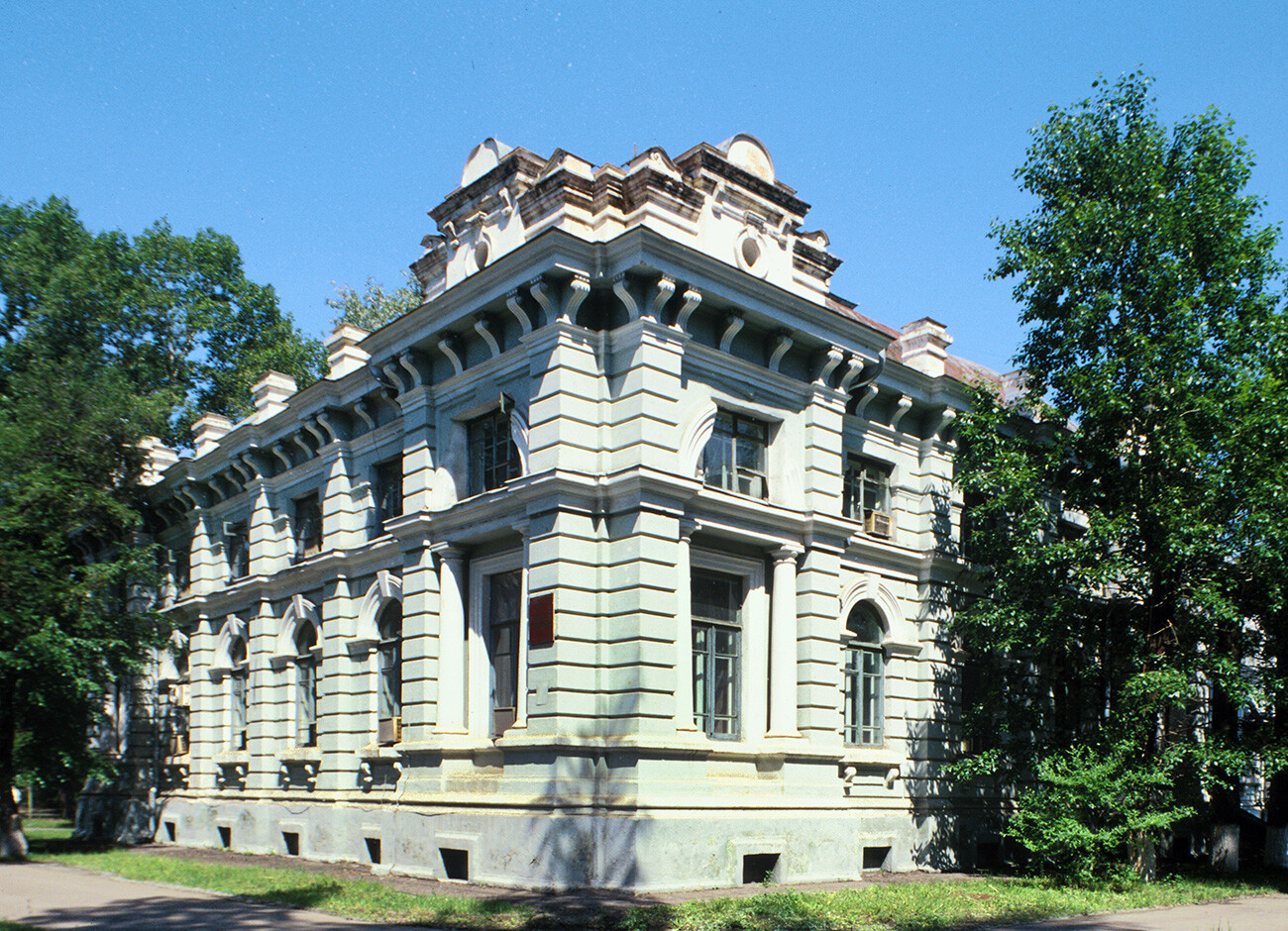
Former Prayer House of Molokan Christians. Built in 1905-07; rebuilt in 1960s as a clinic. June 13, 2002
By the 1913 census, Blagoveshchensk had over doubled in size, to some 70,000 inhabitants. This growth and prosperity was severely damaged by the violence of the Russian Civil War, which raged in Siberia until 1921. Until 1920, the city was under the control of White forces, supported by a Japanese occupation contingent. In 1920, Blagoveshchensk became part of the Far Eastern Republic, nominally independent but allied with the Russian Soviet Republic and serving as a buffer between Japan.
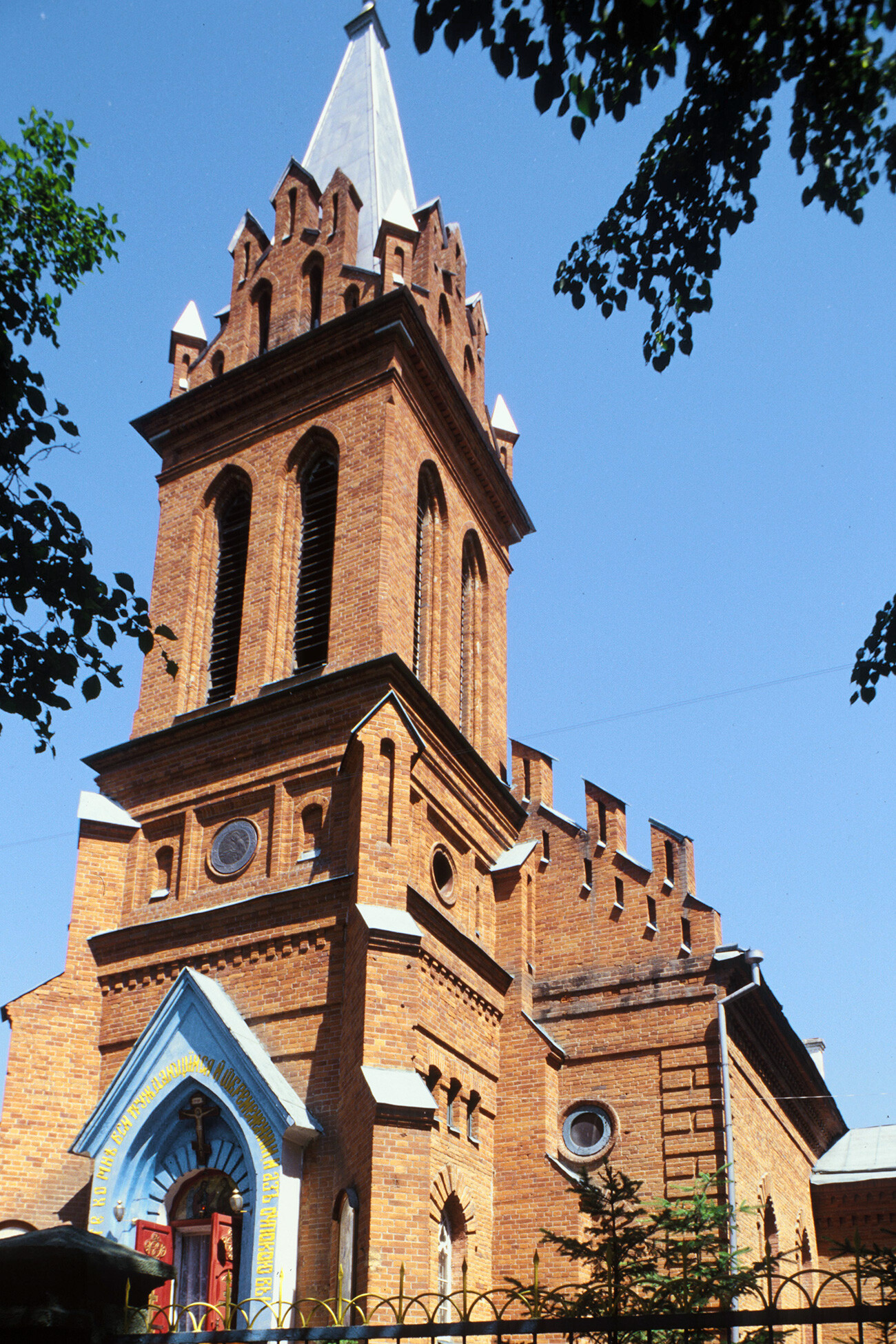
Former Catholic Cathedral of the Annunciation. Built in 1896, with bell tower added in 1911. Building transferred to Orthodox church in 1940s, when it became the Annunciation Cathedral. Now Church of Archangel Gabriel. June 13, 2002
With the withdrawal of the Japanese in 1922, the Far Eastern Republic became a part of the RSFSR (after 1922, the Soviet Union). Tensions again rose to a high level following the Japanese occupation of Manchuria in the 1930s and continued until the victorious conclusion of World War II in September 1945.
A blend of old & new
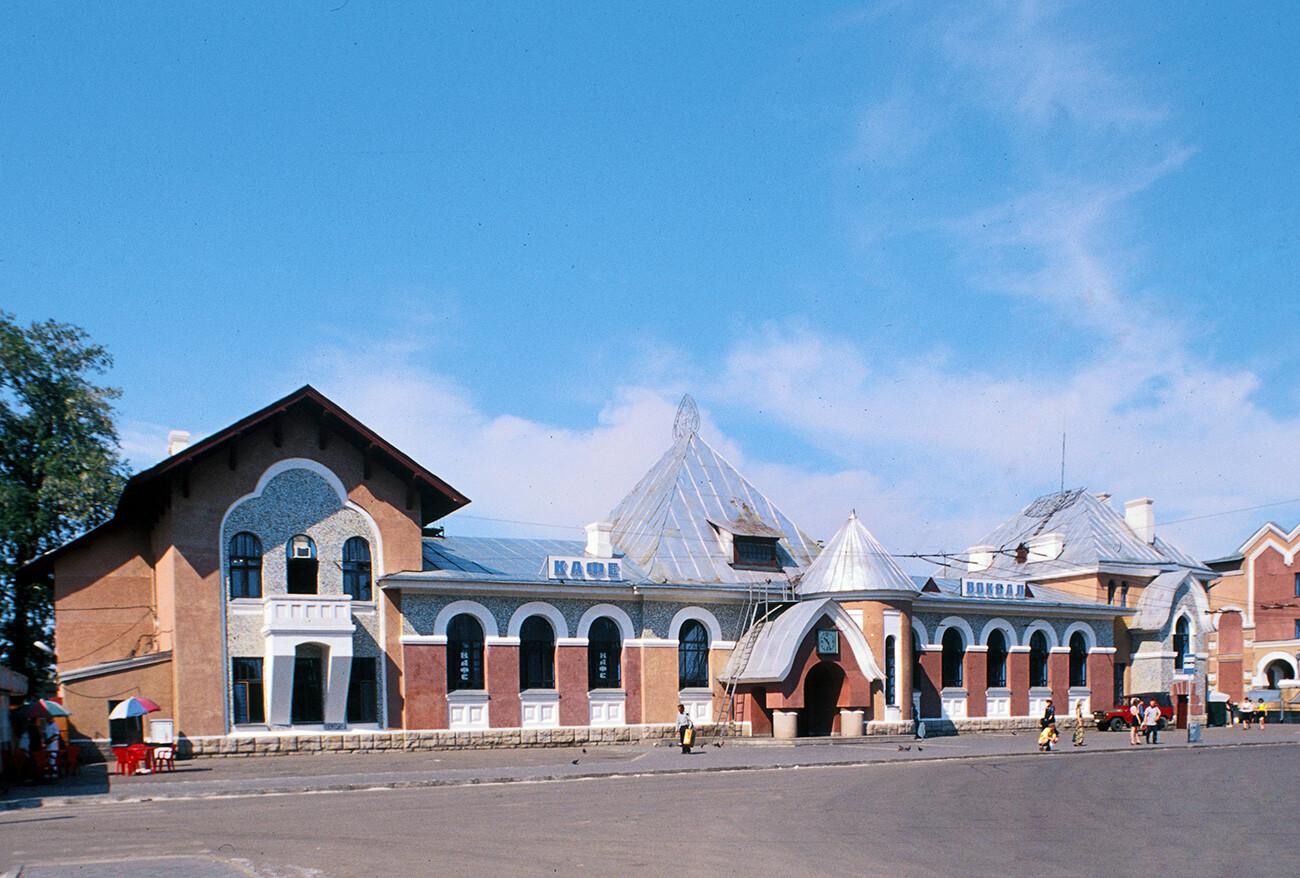
Railroad Station, completed in 1915. June 14, 2002
As the administrative center of the Amur Province (since 1932), Blagoveshchensk, whose current population is around 240,000, continues to occupy an important strategic position in the Russian Far East and forms a free trade zone with the rapidly growing Chinese city of Heihe, situated on the opposite bank of the Amur. Blagoveshchensk has significant potential through expanding economic cooperation with China on both a regional and national level, especially in the major development of energy resources between Russia and China.
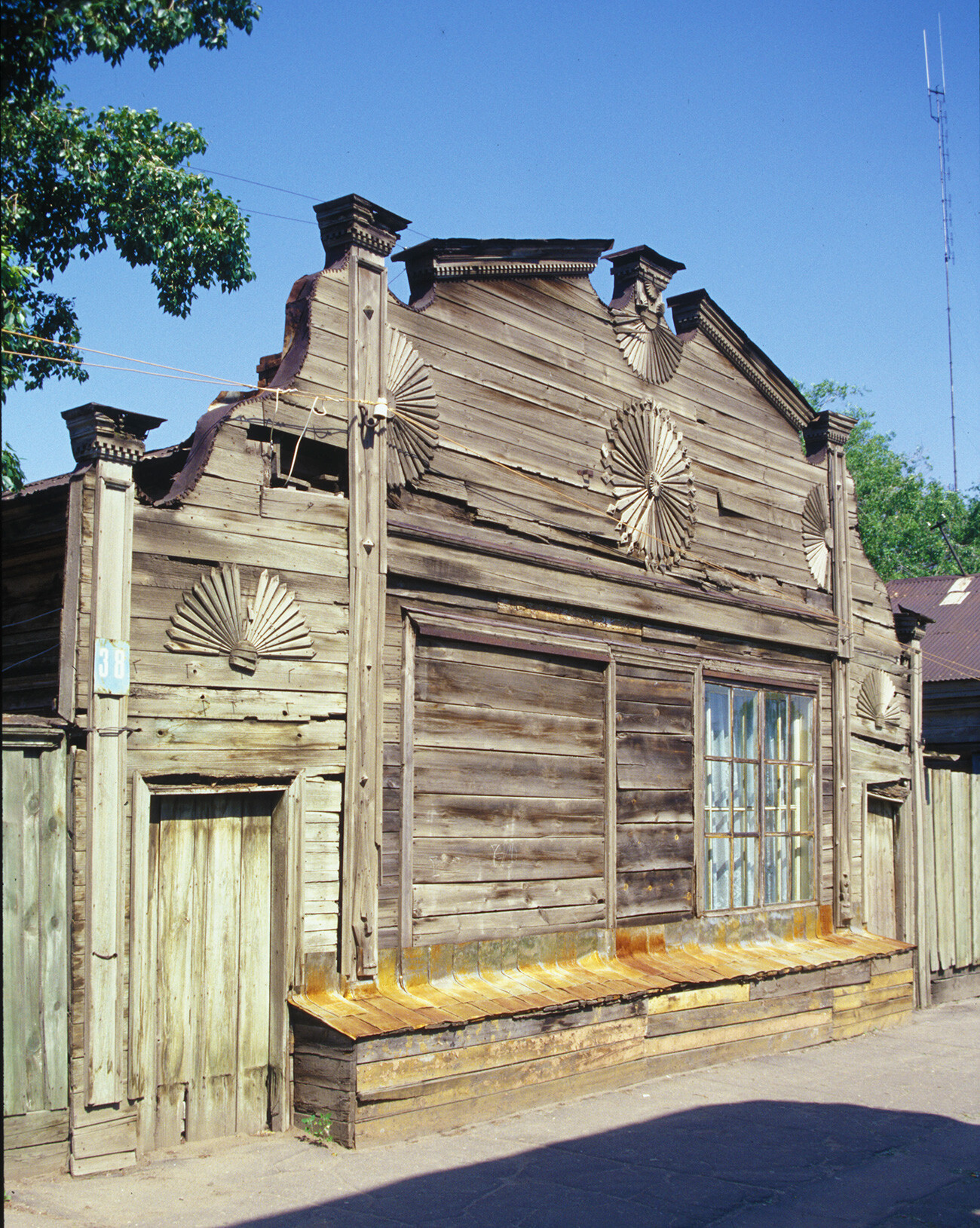
Wooden house, Khmelnitsky Street 38. June 14, 2002
At the same time, Blagoveshchensk has managed to preserve much of its architectural environment from a century ago, a time when the energetic young city looked to the future with hope and faith. In addition to imposing commercial buildings, several of the city's early houses, in brick and wood, remain with their ornamental details.
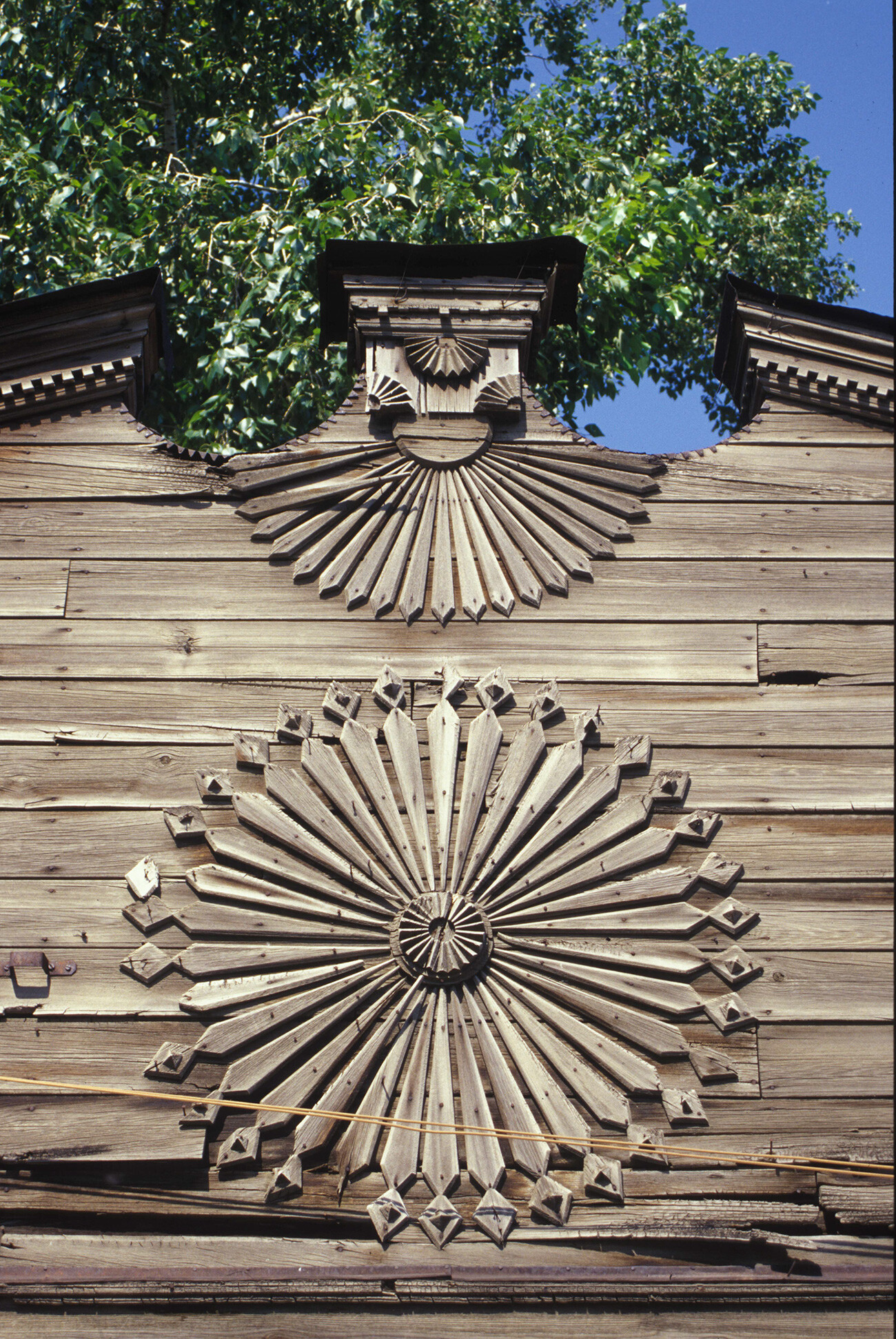
Wooden house, Khmelnitsky Street 38. Ornamental solar motif. June 14, 2002
A strong Regional History Museum, founded in 1891, has provided an essential link with the city's cultural heritage. In 1981, the museum was given one of the city’s early brick buildings, constructed in the late 19th century for the Kunst and Albers department store network, which was established by two German entrepreneurs for trade in the new territories of the Russian Far East.
In conclusion, it is worth noting that the great writer Anton Chekhov visited Blagoveshchensk in late June 1890 as part of his investigative journey to Sakhalin Island. Chekhov wrote about the town glowingly: “I am in love with the Amur and would gladly live here for two years. It is beautiful, spacious, free and warmhearted.”
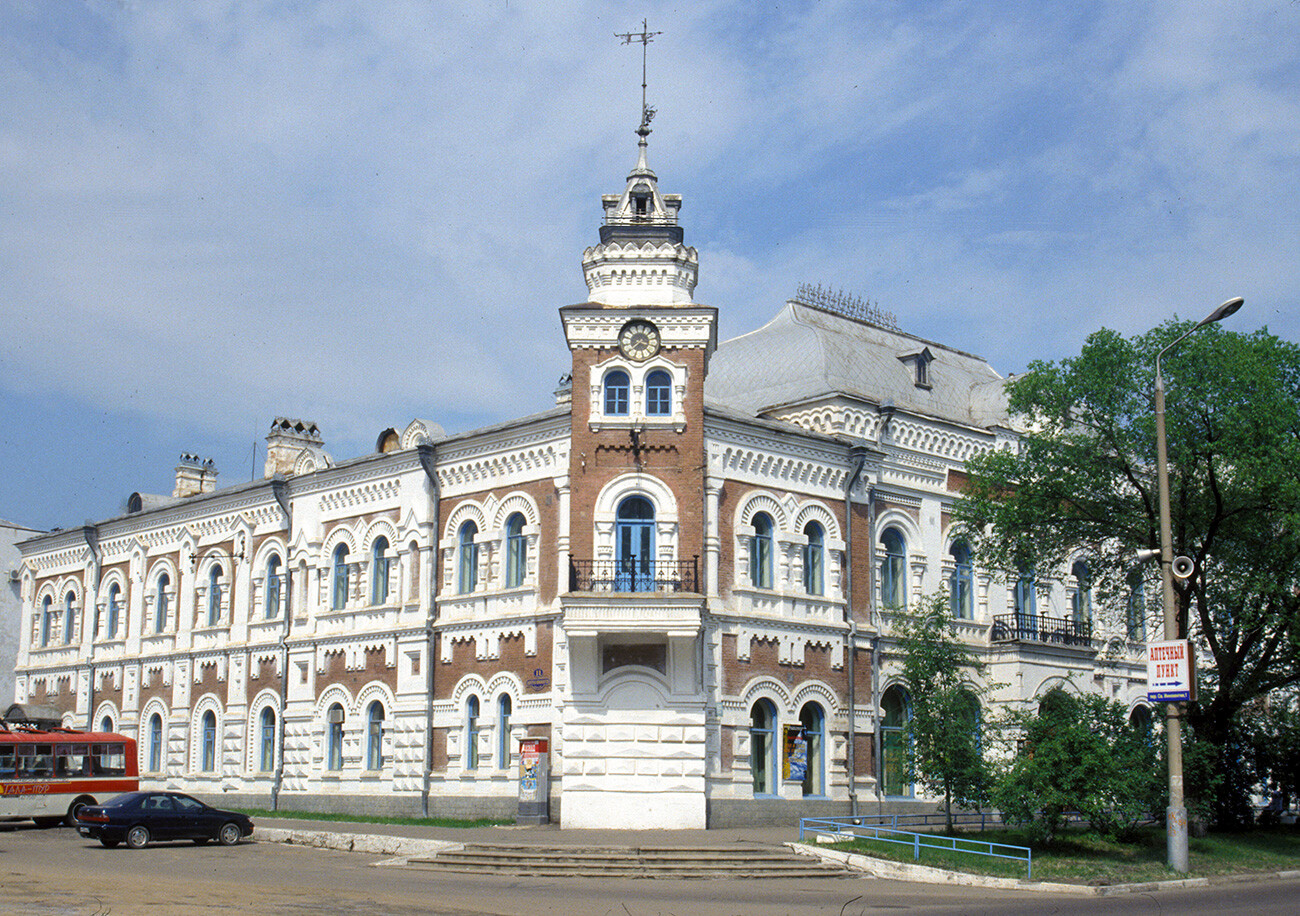
Former Kunst and Albers Department Store (1894), Lenin Street 165. Now Amur Regional History Museum. June 13, 2002
In the early 20th century, Russian photographer Sergey Prokudin-Gorsky developed a complex process for color photography. Between 1903 and 1916, he traveled through the Russian Empire and took over 2,000 photographs with the process, which involved three exposures on a glass plate. In August 1918, he left Russia and ultimately resettled in France where he was reunited with a large part of his collection of glass negatives, as well as 13 albums of contact prints. After his death in Paris in 1944, his heirs sold the collection to the Library of Congress. In the early 21st century, the Library digitized the Prokudin-Gorsky Collection and made it freely available to the global public. A few Russian websites now have versions of the collection. In 1986, architectural historian and photographer William Brumfield organized the first exhibit of Prokudin-Gorsky photographs at the Library of Congress. Over a period of work in Russia beginning in 1970, Brumfield has photographed most of the sites visited by Prokudin-Gorsky. This series of articles juxtaposes Prokudin-Gorsky’s views of architectural monuments with photographs taken by Brumfield decades later.
If using any of Russia Beyond's content, partly or in full, always provide an active hyperlink to the original material.
to our newsletter!
Get the week's best stories straight to your inbox
- The Mozhaisk St. Nicholas Cathedral: From Prokudin-Gorsky to the present
- William Brumfield: The American who made Russia’s architectural heritage famous abroad
- U.S. professor continues photographic legacy of Prokudin-Gorsky in new book
This website uses cookies. Click here to find out more.
Blagoveshchensk
Early history of the region, russian settlement, the boxer rebellion, civil war and the soviet era, administrative and municipal status, transportation, universities, sister city, external links.
The Amur has formed Russia's border with China since the 1858 Aigun Treaty and the 1860 Treaty of Peking . The area north of the Amur belonged to the Manchu Qing dynasty by the Treaty of Nerchinsk of 1689 until it was ceded to Russia by the Aigun Treaty in 1858.
The early residents of both sides of the Amur in the region of today's Blagoveshchensk were the Daurs and Duchers . An early settlement in the area of today's Blagoveshchensk was the Ducher town whose name was reported by the Russian explorer Yerofey Khabarov as Aytyun in 1652, as Aigun from 1683 to 1685, and as Aigun Old Town from 1685 until the massacre in 1900 , [17] which known to Russian archaeologists as the Grodekovo site, after the nearby village of Grodekovo some 25–30 km (16–19 mi ) southeast of Blagoveshchensk. The Grodekovo site is thought by archaeologists to have been populated since ca. 1000 CE. [18]

As the Russians tried to assert their control over the region, the Ducher town was probably vacated when the Duchers were evacuated by the Qing to the Sungari or Hurka in the mid-1650s. [18] Since 1673, the Chinese re-used the site for their fort ("Old Aigun", in modern literature), [19] which served in 1683-1685 as a base for the Manchus' campaign against the Russian fort of Albazin further north. [20]
After the capture of Albazin in 1685 or 1686, the Chinese relocated their town, to a new site on the right (southwestern, i.e. presently Chinese) bank of the Amur, about 3 miles (4.8 km) downstream from the original site; it later became known as Aigun . [21] [22]
The series of conflicts between Russians and China ended with Russia's recognition of the Chinese sovereignty over both sides of the Amur by the Nerchinsk Treaty of 1689.
As the balance of power in the region had changed by the mid-19th century, the Russian Empire was able to take over the left (generally northern, but around Blagoveshchensk, eastern) bank of the Amur from China. Since the 1858 Aigun Treaty and the 1860 Treaty of Peking , the river has remained the border between the countries, although the Qing subjects were allowed to continue to live in the so-called Sixty-Four Villages east of the Amur and the Zeya (i.e., within today's Blagoveshchensk's eastern suburbs).

Although Russian settlers had lived in the area as early as 1644 and was known as Hailanpao ( Chinese : 海兰泡 ; simplified Chinese : 海兰泡 ; traditional Chinese : 海蘭泡 ; pinyin : Hǎilánpāo ), the present-day city began in 1856 [3] as the military outpost of Ust-Zeysky ; this name means settlement at the mouth of the Zeya River in Russian. Tsar Alexander II gave approval for the founding of the city in 1858 as the seat of government for the Amur region, to be named Blagoveshchensk (literally "the city of good news") after the parish church which was dedicated to the Annunciation . According to Blagoveshchensk authorities, by 1877 the city had some 8,000 residents, with merely 15 foreigners (presumably, Chinese) among them. [19]
The city was an important river port and trade center during the late 19th century, with growth further fueled by a gold rush early in the 20th century and by its position on the Chinese border opposite the city of Heihe .
Local historians noted the pre-eminence of Blagoveshchensk in the economy of the late 19th century Russian Far East , which was reflected when the heir to the Russian throne, Nicholas Alexandrovich (the future Tsar Nicholas II), visited in 1891 during his grand tour of Asiatic Russia , and the locals presented him with bread and salt on a gold tray, rather than on a silver one as in other cities of the region. [23]
In the course of the Boxer Rebellion , the Qing Imperial army (made out of Manchus and Han Chinese) and Boxer insurgents shelled the city in July 1900. Chinese Honghuzi forces joined the attack against Blagoveshchensk. [24] According to the Orthodox belief, the city was allegedly saved by a miraculous icon of Our Lady of Albazin, which was prayed to continuously during the shelling which lasted almost two weeks.
On 3 July ( Old Style ), a decision was made by the city's Police Chief Batarevich and the Military Governor Gribsky to deport the city's entire community of Qing subjects including ethnic Manchus , Daur people and Han, numbering 4,008 [19] ), who were viewed as potential fifth columnists . As cross-river shipping was interrupted by the rebellion, the question arose how to get them from the Russian to the Chinese side of the Amur. Batarevich suggested that the deportees could be first taken east of the Zeya , where they should obtain boats from the local Chinese villagers. The plan, however, was vetoed by the governor, and the decision was made instead to take the deportees to the stanitsa of Verkhneblagoveshchenskaya—the place where the Amur is at its narrowest—and make them leave Russia there. As the local ataman refused to provide boats to take them across the river (despite the orders of his superior), few of them made it to the Chinese side. The rest drowned in the Amur, or were shot or axed by the police, Cossacks and local volunteers, when refusing to leave the bank. Local Chinese memory holds that a massacre that took place then, at the hand of Cossacks, which killed so many that the Amur River was choked. [25] According to Chinese sources, about 5,000 people reportedly died during these events of 4–8 July 1900. [26]
There were 1,266 households in the city, including 900 Daurs and 4,500 Manchus until the massacre. [27] Many Manchu villages were burned by Cossacks in the massacre according to Victor Zatsepine. [28]
This expulsion of the local Chinese caused some hardships for Blagoveshchensk consumers. For example, during the second half of 1900 it became almost impossible to buy any green vegetables in the town, and ten eggs would cost 30-50 kopecks (and in winter, as much as a rouble), while before it had been possible to buy ten eggs for 10-15 kopecks. [19]
The massacre angered the Chinese, and had ramifications for the future: the Chinese Honghuzi fought a guerilla war against Russian occupation and assisted the Japanese in the Russo-Japanese War against the Russians in revenge. Louis Livingston Seaman mentioned the massacre as being the reason for the Chinese Honghuzi hatred towards the Russians:
The Chinaman, be he Hung-hutze or peasant, in his relation to the Russians in this conflict with Japan has not forgotten the terrible treatment accorded him since the Muscovite occupation of Manchuria. He still remembers the massacre at Blagovestchensk when nearly 8,000 unarmed men, women, and children were driven at the point of the bayonet into the raging Amur, until — as one of the Russian officers who participated in that brutal murder told me at Chin-Wang-Tao in 1900 — "the execution of my orders made me almost sick, for it seemed as though I could have walked across the river on the bodies of the floating dead." Not a Chinaman escaped, except forty who were employed by a leading foreign merchant who ransomed their lives at a thousand roubles each. These, and many even worse, atrocities are remembered and now is their moment for revenge. So it was easy for Japan to enlist the sympathy of these men, especially when emphasized by liberal pay, as is now the case. It is believed that more than 10,000 of these bandits, divided into companies of from 200 to 300 each and led by Japanese officers, are now in the pay of Japan. [29]

The city was also the site of conflict during the Russian Civil War , with Japanese troops occupying the city in support of the White Army . From 1920 until 1922, the city was declared part of the Far Eastern Republic , an area which was nominally independent, but in reality a buffer zone under control of the Russian SFSR . The city became the administrative center of Amur Oblast in 1932.
During the Cultural Revolution in China, the city was subject to Maoist propaganda blasted from loudspeakers across the river 24 hours a day. [30]

Blagoveshchensk is the administrative center of the oblast [1] and, within the framework of administrative divisions , it also serves as the administrative center of Blagoveshchensky District , [10] even though it is not a part of it. [1] As an administrative division, it is, together with six rural localities , incorporated separately as Blagoveshchensk Urban Okrug —an administrative unit with the status equal to that of the districts . [1] As a municipal division , this administrative unit also has urban okrug status. [9]
In July 2013, a public hearing was held at which citizens declared themselves to be in favor of a return to the direct election of the mayor. A meeting of deputies voted for rejection of the "two-headed" management. In September 2013, City Council voted for a return to the mayoral election of the mayor. [ clarification needed ] [31]
The city is located at the confluence of the Amur and the Zeya Rivers, opposite to the Chinese city of Heihe.
Blagoveschensk experiences a monsoon-influenced hot-summer humid continental climate ( Köppen Dwa ), bordering on a monsoon-influenced warm-summer humid continental climate ( Dwb ) which it had before 1990. The climate is very strongly continental. The city features frigid, windy, but dry winters due to the influence of the Siberian high , and warm, wet summers, due to the East Asian monsoon . On 1 August 2011, it became the first city in the Russian Far East to be hit by a tornado. [ citation needed ]
Since the dissolution of the Soviet Union , the city's economic focus has turned to border trade with China. The town is now home to a large Chinese expatriate community. Blagoveshchensk is part of a free trade zone which includes the Chinese city of Heihe, located on the other side of the Amur River. [34]
Main industries in the town include metal and timber processing, as well as paper production. [ citation needed ]

The city is served by a branch highway and railway connecting it to Belogorsk on the Trans-Siberian Railway and Trans-Siberian Highway . It is also served by a river port. On the other side of the Amur River is Heihe , Heilongjiang Province , China, which is the starting point of China National Highway 202 that goes south to Harbin and Dalian . Ignatyevo Airport , located 20 kilometers (12 mi) northwest of the city center, serves domestic destinations.
The Blagoveshchensk–Heihe Bridge , completed at the end of 2019, includes a 2-lane highway bridge over the Amur to link Blagoveshchensk and Heihe.
The world's first international cable car to Heihe has also been proposed to open in 2022. [35] [36]
- Amur State Medical Academy [37]
- Amur State University
- Blagoveshchensk State Pedagogical University
- Far Eastern Higher Combined Arms Command School
- Far Eastern State Agricultural University [38]
- Finance University under the Government of the Russian Federation (Blagoveschensk Branch)
- Maritime State University named after admiral Gennady Nevelskoy (Blagoveschensk Branch)
- Modern University for the Humanities (Blagoveschensk Branch)
- Moscow Academy of Business in Association with the Government of Moscow (Blagoveschensk Branch) [ citation needed ]
- Nikolay Muravyov-Amursky
- Amur Cossacks
Related Research Articles

Tynda is a town in Amur Oblast, Russia, located 568 kilometers (353 mi) northwest of Blagoveshchensk. It is an important railway junction, informally referred to as the capital of the Baikal-Amur Mainline. Its population has declined sharply in recent years: 36,275 (2010 Russian census) ; 40,094 (2002 Census) ; 61,996 (1989 Soviet census) .
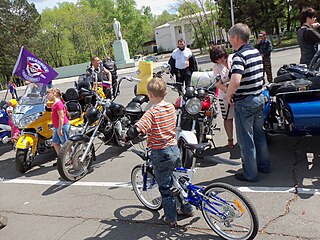
Raychikhinsk is a town in Amur Oblast, Russia, located in the Zeya–Bureya basin, about 40 kilometers (25 mi) from the Amur River and the border with China, and about 165 kilometers (103 mi) east of Blagoveshchensk, the administrative center of the oblast. Population: 20,534 (2010 Russian census) ; 24,498 (2002 Census) ; 27,873 (1989 Soviet census) .
Zavitinsk is a town and the administrative center of Zavitinsky District in Amur Oblast, Russia. Population: 11,481 (2010 Russian census) ; 14,248 (2002 Census) ; 21,838 (1989 Soviet census) .
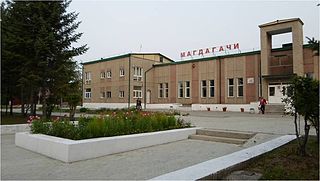
Magdagachi is an urban locality and the administrative center of Magdagachinsky District of Amur Oblast, Russia, located 367 kilometers (228 mi) northwest of Blagoveshchensk. Population: 10,897 (2010 Russian census) ; 12,208 (2002 Census) ; 15,578 (1989 Soviet census) .
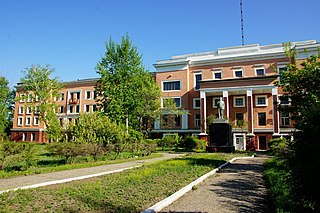
Svobodny is a town in Amur Oblast, Russia, located on the right bank of the Zeya River, 167 kilometers (104 mi) north of Blagoveshchensk, the administrative center of the oblast. Population: 58,778 (2010 Russian census) ; 63,889 ; 80,006 (1989 Soviet census) .

Skovorodino is a town and the administrative center of Skovorodinsky District of Amur Oblast, Russia, located in the upper stream of the Bolshoy Never River 669 kilometers (416 mi) northwest of Blagoveshchensk, the administrative center of the oblast. Skovorodino is located 54 kilometers (34 mi) from the border with Heilongjiang, China. Population: 9,564 (2010 Russian census) ; 10,566 (2002 Census) ; 13,824 (1989 Soviet census) .
Progress is an urban locality in Amur Oblast, Russia, located southeast of Blagoveshchensk, the administrative center of the oblast. Population: 11,156 (2010 Russian census) ; 13,080 (2002 Census) ; 14,345 (1989 Soviet census) .

Arkharinsky District is an administrative and municipal district (raion), one of the twenty in Amur Oblast, Russia. The area of the district is 14,355 square kilometers (5,542 sq mi). Its administrative center is the urban locality of Arkhara. Population: 17,186 (2010 Russian census) ; 21,068 ; 27,537 (1989 Soviet census) . The population of Arkhara accounts for 55.8% of the district's total population.

Belogorsky District is an administrative and municipal district (raion), one of the twenty in Amur Oblast, Russia. The area of the district is 2,591 square kilometers (1,000 sq mi). Its administrative center is the town of Belogorsk. Population: 20,052 (2010 Russian census) ; 23,848 ; 28,648 (1989 Soviet census) .

Blagoveshchensky District is an administrative and municipal district (raion), one of the twenty in Amur Oblast, Russia. The area of the district is 3,060 square kilometers (1,180 sq mi). Its administrative center is the city of Blagoveshchensk. Population: 19,641 (2010 Russian census) ; 18,673 ; 18,192 (1989 Soviet census) .
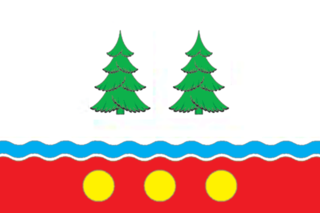
Mazanovsky District is an administrative and municipal district (raion), one of the twenty in Amur Oblast, Russia. The area of the district is 28,316 square kilometers (10,933 sq mi). Its administrative center is the rural locality of Novokiyevsky Uval. Population: 14,803 (2010 Russian census) ; 16,028 ; 20,393 (1989 Soviet census) . The population of Novokiyevsky Uval accounts for 29.2% of the district's total population.

Skovorodinsky District is an administrative and municipal district (raion), one of the twenty in Amur Oblast, Russia. The area of the district is 20,509 square kilometers (7,919 sq mi). Its administrative center is the town of Skovorodino. Population: 29,558 (2010 Russian census) ; 34,269 ; 42,998 (1989 Soviet census) . The population of Skovorodino accounts for 32.4% of the district's total population.
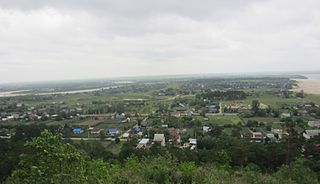
Svobodnensky District is an administrative and municipal district (raion), one of the twenty in Amur Oblast, Russia. The area of the district is 7,318 square kilometers (2,825 sq mi). Its administrative center is the town of Svobodny. Population: 14,315 (2010 Russian census) ; 14,568 ; 16,879 (1989 Soviet census) .

Tyndinsky District is an administrative and municipal district (raion), one of the twenty in Amur Oblast, Russia. The area of the district is 83,258 square kilometers (32,146 sq mi). Its administrative center is the town of Tynda. Population: 16,065 (2010 Russian census) ; 16,701 ; 35,067 (1989 Soviet census) .

Zavitinsky District is an administrative and municipal district (raion), one of the twenty in Amur Oblast, Russia. The area of the district is 3,286 square kilometers (1,269 sq mi). Its administrative center is the town of Zavitinsk. Population: 15,970 (2010 Russian census) ; 20,198 ; 29,637 (1989 Soviet census) . The population of Zavitinsk accounts for 71.9% of the district's total population.

Zeysky District is an administrative and municipal district (raion), one of the twenty in Amur Oblast, Russia. The area of the district is 87,486 square kilometers (33,779 sq mi). Its administrative center is the town of Zeya. Population: 16,847 (2010 Russian census) ; 20,827 ; 42,298 (1989 Soviet census) .

Zeya is a town in Amur Oblast, Russia, located on the Zeya River 230 kilometers (140 mi) southeast of Tynda and 532 kilometers (331 mi) north of Blagoveshchensk.
Novobureysky is an urban locality and the administrative center of Bureysky District of Amur Oblast, Russia. Population: 8,344 (2010 Russian census) ; 8,892 (2002 Census) ; 8,988 (1989 Soviet census) .
Seryshevo is an urban locality and the administrative center of Seryshevsky District of Amur Oblast, Russia. Population: 10,816 (2010 Russian census) ; 12,186 (2002 Census) ; 13,456 (1989 Soviet census) .
Ushumun is an urban locality in Magdagachinsky District of Amur Oblast, Russia. Population: 2,390 (2010 Russian census) ; 2,920 (2002 Census) ; 3,232 (1989 Soviet census) .
- 1 2 3 4 5 6 7 8 Law #127-OZ
- ↑ Decision #14/60
- 1 2 Charter of Blagoveshchensk, Article 17
- ↑ Official website of Blagoveshchensk. City Leadership Administration Archived 2023-10-20 at the Wayback Machine (in Russian)
- ↑ Federal State Statistics Service . Показатели, характеризующие состояние экономики и социальной сферы муниципального образования. Город Благовещенск (in Russian)
- 1 2 Russian Federal State Statistics Service (2011). Всероссийская перепись населения 2010 года. Том 1 [ 2010 All-Russian Population Census, vol. 1 ] . Всероссийская перепись населения 2010 года [2010 All-Russia Population Census] (in Russian). Federal State Statistics Service .
- ↑ "26. Численность постоянного населения Российской Федерации по муниципальным образованиям на 1 января 2018 года" . Federal State Statistics Service . Retrieved 23 January 2019 .
- 1 2 3 Law #447-OZ
- 1 2 Law #51-OZ
- ↑ "Об исчислении времени" . Официальный интернет-портал правовой информации (in Russian). 3 June 2011 . Retrieved 19 January 2019 .
- ↑ Почта России. Информационно-вычислительный центр ОАСУ РПО. ( Russian Post ). Поиск объектов почтовой связи ( Postal Objects Search ) (in Russian)
- ↑ Charter of Blagoveshchensk, Article 1
- ↑ Russian Federal State Statistics Service. Всероссийская перепись населения 2020 года. Том 1 [ 2020 All-Russian Population Census, vol. 1 ] (XLS) (in Russian). Federal State Statistics Service .
- ↑ Federal State Statistics Service (21 May 2004). Численность населения России, субъектов Российской Федерации в составе федеральных округов, районов, городских поселений, сельских населённых пунктов – районных центров и сельских населённых пунктов с населением 3 тысячи и более человек [ Population of Russia, Its Federal Districts, Federal Subjects, Districts, Urban Localities, Rural Localities—Administrative Centers, and Rural Localities with Population of Over 3,000 ] (XLS) . Всероссийская перепись населения 2002 года [All-Russia Population Census of 2002] (in Russian).
- ↑ Всесоюзная перепись населения 1989 г. Численность наличного населения союзных и автономных республик, автономных областей и округов, краёв, областей, районов, городских поселений и сёл-райцентров [ All Union Population Census of 1989: Present Population of Union and Autonomous Republics, Autonomous Oblasts and Okrugs, Krais, Oblasts, Districts, Urban Settlements, and Villages Serving as District Administrative Centers ] . Всесоюзная перепись населения 1989 года [All-Union Population Census of 1989] (in Russian). Институт демографии Национального исследовательского университета: Высшая школа экономики [Institute of Demography at the National Research University: Higher School of Economics]. 1989 – via Demoscope Weekly .
- ↑ Maxwell, Neville (June 2007), "How the Sino-Russian Boundary Conflict Was Finally Settled: From Nerchinsk 1689 to Vladivostok 2005 via Zhenbao Island 1969" (PDF) , in Iwashita, Akihiro (ed.), Eager Eyes Fixed on Eurasia , 21st Century COE Program Slavic Eurasian Studies, Sapporo: Slavic Research Center, Hokkaido University, p. 56 , retrieved 24 February 2009
- 1 2 Амурская область: История. Народы Амурской земли Archived 18 July 2011 at the Wayback Machine (Amur Oblast - the History. The peoples of the Amur Land) (in Russian)
- 1 2 3 4 Олег Анатольевич Тимофеев (Oleg Anatolyevich Timofeyev). "Российско-китайские отношения в Приамурье (сер. XIX – нач. XX вв.)" ( Russian-Chinese relations in the Amur region, mid-19th - early 20th centuries ). Part 1. Blagoveshchensk, 2003.
- ↑ Bruce Mancall, Russia and China:Their Diplomatic Relations to 1728 (1971), pp. 115-127.
- ↑ E. G. Ravenstein , The Russians on the Amur . London (1861), pg. 48.
- ↑ Note that the distance between modern Grodekovo and the historic Aigun on the Chinese side of the river is about 15 kilometers (9.3 mi) on modern maps, rather than 3 miles (4.8 km) , as Ravenstein states. However, the location of the Grodekovo archaeological site (i.e., the "Old Aigun") may be quite a distance from the eponymous village; and Ravenstein may be somewhat imprecise in the number.
- ↑ Валентина Кобзарь (Valentina Kobzar). Сколько «Царских ворот» на Дальнем Востоке? Память о путешествии Николая II ( How many "Royal Gates" are there in the Far East? )
- ↑ Joana Breidenbach (2005). Pál Nyíri, Joana Breidenbach (ed.). China inside out: contemporary Chinese nationalism and transnationalism (illustrated ed.). Central European University Press. p. 90. ISBN 963-7326-14-6 . Retrieved 18 March 2012 . The political component of Chinese banditism emerged only in the year 1900. For the first time, Khunkhuzy attacked the Russian city of Blagoveshchensk. It ended in the drowning of about 3,000 Chinese near Blagoveshchensk (called Hailanbao in Chinese). When during the Boxer Uprising Boxers and khunkhuzy assaulted Russian positions nearby, Cossacks stationed there decided to drive the Chinese from the Russian bank of the river back onto the Chinese bank. People were simply pushed into the river, and many of them drowned. Even Vladimir Lenin personally criticized the Russian tsarist government for its brutality.
- ↑ Colin Thubron , The Amur River: Between Russia and China, Random House , 2021 ISBN 978-1-473-56591-3 pp. 131-133.
- ↑ Олег Анатольевич Тимофеев (Oleg Anatolyevich Timofeyev). "Российско-китайские отношения в Приамурье (сер. XIX – нач. XX вв.)" ( Russian-Chinese relations in the Amur region, mid-19th - early 20th centuries ). Part 2. Blagoveshchensk, 2003. Quote: "3 июля благовещенский полицмейстер Батаревич предложил военному губернатору Амурской области К.Н. Грибскому депортировать китайцев на правый берег... Сразу же возник вопрос о транспортных средствах для перевозки нескольких тысяч человек... Батаревич в конечном итоге принял решение о переправе всех китайцев в районе ст. Верхнеблаговещенской – месте, где Амур наиболее узок... По прибытии в ст. Верхнеблаговещенскую события приняли еще более драматический оборот. Местный атаман Писарев, несмотря на приказ председателя амурского войскового правления полковника Волковинского, наотрез отказался предоставить китайцам имевшиеся у него шаланду и лодки, опасаясь их захвата противником. Китайцам было предложено переправляться самим, хотя среди них имелись старики и дети. К этому времени к берегу подошли озлобленные продолжающимся обстрелом местные жители. Совершенно естественное нежелание депортируемых самим идти на смерть окружившими их русскими было воспринято почти как вооруженное восстание. Во время последующего следствия Шабанов и Писарев пытались обвинить друг друга в попустительстве началу расправы. Начальник конвоя указывал в рапорте, что стрелял один из местных казаков, неизвестно по чьему приказу. При опросе атамана и казаков станицы ими было заявлено, что переправа (то есть истребление – О.Т.) началась лишь после того, как помощник пристава «принял более строгие меры». На деле эти меры свелись к уничтожению безоружных китайцев как на берегу, так и уже в воде. Как гласят цинские источники, депортируемых связывали косами по пять-шесть человек и штыками загоняли в воду. Отказавшихся переправляться Шабанов приказал, по свидетельству очевидцев, зарубить топорами. По некоторым данным, огонь был открыт и с цинской стороны. Из всей партии до противоположного берега доплыли лишь 80-100 человек".
- ↑ 俄罗斯帝国总参谋部. 《亚洲地理、地形和统计材料汇编》. 俄罗斯帝国: 圣彼得堡. 1886年: 第三十一卷·第185页 (俄语).
- ↑ Higgins, Andrew (26 March 2020). "On Russia-China Border, Selective Memory of Massacre Works for Both Sides" . The New York Times.
- ↑ Louis Livingston Seaman (1904). From Tokio through Manchuria with the Japanese . PRINTED AT THE APPLETON PRESS, NEW YORK, U.S.A.: S. Appleton. p. 170 . Retrieved 18 March 2012 . ant, in his relation to the Russians in this conflict with Japan has not forgotten the terrible treatment accorded him since the Muscovite occupation of Manchuria. He still remembers the massacre at Blagovestchensk when nearly 8,000 unarmed men, women, and children were driven at the point of the bayonet into the raging Amur, until—as one of the Russian officers who participated in that brutal murder told me at Chin-Wang-Tao in 1900—" the execution of my orders made me almost sick, for it seemed as though I could have walked across the river on the bodies of the floating dead." Not a Chinaman escaped, except forty who were employed by a leading foreign merchant who ransomed their lives at a thousand roubles each. These, and many even worse, atrocities are remembered and now is their moment for revenge. So it was easy for Japan to enlist the sympathy of these men, especially when emphasized by liberal pay, as is now the case. It is believed that more than 10,000 of these bandits, divided into companies of from 200 to 300 each and led by Japanese officers, are now in the pay of Japan. LONDON: SIDNEY APPLETON COPYRIGHT, 1904, BY D. APPLETON AND COMPANY Original from the University of California Digitized 21 November 2007.
- ↑ Fatland, Erika (2020). The Border - A Journey Around Russia . Quercus. ISBN 9780857057792 . Retrieved 21 July 2022 .
- ↑ Жители Благовещенска снова будут выбирать мэра уже со следующего года
- ↑ "Климат Благовещенска" (in Russian). Погода и Климат . Retrieved 8 November 2021 .
- ↑ "Blagovescensk Climate Normals 1961–1990" . National Oceanic and Atmospheric Administration . Retrieved 3 November 2021 .
- ↑ "Blagoveshchensk: Russia's anchor on the Amur River" . Russia Beyond the Headlines. 16 May 2011.
- ↑ Amy Woodyatt. "The world's first cross-border cable car will travel from Russia to China in under 8 minutes" . CNN .
- ↑ "Russia to China in under eight minutes: World's first cross-border cable car unveiled" . abc.net.au . 31 July 2019.
- ↑ Amur State Medical Academy , recas.ru. Accessed 9 October 2022.
- ↑ Far Eastern State Agricultural University profile , topuniversitieslist.com. Accessed 9 October 2022.
- ↑ Blagoveshchensk and Heihe partner cities Archived August 20, 2007, at the Wayback Machine
- Амурский областной Совет народных депутатов. Закон №127-ОЗ от 23 декабря 2005 г. «О порядке решения вопросов административно-территориального устройства Амурской области», в ред. Закона №272-ОЗ от 11 ноября 2013 г. «О внесении изменений в Закон Амурской области "О порядке решения вопросов административно-территориального устройства Амурской области"». Вступил в силу со дня первого официального опубликования, за исключением подпункта "б" пункта 2 статьи 7, вступающего в силу с 1 января 2006 г. Опубликован: "Амурская правда", №11, 24 января 2006 г. (Amur Oblast Council of People's Deputies. Law # 127-OZ of December 23, 2005 On the Procedures of Handling the Issues of the Administrative and Territorial Structure of Amur Oblast , as amended by the Law # 272-OZ of November 11, 2013 On Amending the Law of Amur Oblast "On the Procedures of Handling the Issues of the Administrative and Territorial Structure of Amur Oblast" . Effective as of the day of the first official publication, with the exception of subitem "b" of item 2 of Article 7, which is effective January 1, 2006.).
- Амурский областной Совет народных депутатов. Закон №447-ОЗ от 14 марта 2005 г «О наделении муниципального образования города Благовещенск статусом городского округа и об установлении его границ», в ред. Закона №175-ОЗ от 26 апреля 2013 г. «О внесении изменений в отдельные законодательные акты Амурской области по вопросам установления границ муниципальных образований». Вступил в силу в соответствии со статьёй 3. Опубликован: "Амурская правда", №61, 25 марта 2005 г. (Amur Oblast Council of People's Deputies. Law # 447-OZ of March 14, 2005 On Granting the Municipal Formation of the Town of Blagoveshchensk the Urban Okrug Status and on Establishing Its Borders , as amended by the Law # 175-OZ of April 26, 2013 On Amending Various Legislative Acts of Amur Oblast on the Issues of Establishing the Borders of the Municipal Formations . Effective as of the date set forth in accordance with the provisions of Article 3.).
- Амурский областной Совет народных депутатов. Закон №51-ОЗ от 21 сентября 2005 г. «Об установлении границ и наделении соответствующим статусом муниципального образования Благовещенского района и муниципальных образований в его составе», в ред. Закона №175-ОЗ от 26 апреля 2013 г. «О внесении изменений в отдельные законодательные акты Амурской области по вопросам установления границ муниципальных образований». Вступил в силу со дня первого опубликования, за исключением статьи 3, вступившей в силу с 1 января 2006 г. Опубликован: "Амурская правда", №190, 27 сентября 2005 г. (Amur Oblast Council of People's Deputies. Law # 51-OZ of September 21, 2005 On Establishing the Borders of and Granting a Corresponding Municipal Formation Status to Blagoveshchensky District and to the Municipal Formations It Comprises , as amended by the Law # 175-OZ of April 26, 2013 On Amending Various Legislative Acts of Amur Oblast on the Issues of Establishing the Borders of the Municipal Formations . Effective as of the day of the first publication, with the exception of Article 3 which took effect on January 1, 2006.).
- Дума города Благовещенска. Решение №62/89 от 26 мая 2005 г. «О принятии Устава муниципального образования города Благовещенска», в ред. Решения №11/119 от 28 мая 2015 г. «О внесении изменений в Устав муниципального образования города Благовещенска». Вступил в силу после официального опубликования. Опубликован: "Благовещенск", №38, 23 сентября 2005 г. (Duma of the City of Blagoveshchensk. Decision # 62/89 of May 26, 2005 On the Adoption of the Charter of the Municipal Formation of the City of Blagoveshchensk , as amended by the Decision # 11/119 of May 28, 2015 On Amending the Charter of the Municipal Formation of the City of Blagoveshchensk . Effective as of after the official publication.).
- Благовещенская городская Дума. Решение №14/60 от 25 мая 2006 г. «О гимне города Благовещенска», в ред. Решения №19/141 от 25 ноября 2010 г. «О внесении изменения в Положение о гимне города Благовещенска, утверждённое решением Благовещенской городской Думы от 25 мая 2006 г. №14/60». Вступил в силу со дня официального опубликования в газете "Благовещенск". Опубликован: "Благовещенск", №22–23, 2 июня 2006 г. (Blagoveshchensk City Duma. Decision # 14/60 of May 25, 2006 On the Anthem of the City of Blagoveshchensk , as amended by the Decision # 19/141 of November 25, 2010 On Amending the Statute on the Anthem of the City of Blagoveshchensk #14/60 Adopted by the Decision of the Blagoveshchensk City Duma of May 25, 2006 . Effective as of the day of the official publication in the Blagoveshchensk newspaper.).
- Official website of Blagoveshchensk (in Russian)
- Blagoveshchensk Business Directory (in Russian)
- Video: Tornado in Blagoveshchensk, July 31, 2011
PRIDE, FRIENDSHIP, TRADITION - SINCE 1948

Yorktown Athletic Club
Travel Head Coaching
YAC is committed to selecting coaches that provide the youth of our community a positive role model. YAC requires
a head coach to display qualities of strong character and good sportsmanship at all times and that he/she demand the same
of his/her assistant coaches, players and parents and that he/she be capable of teaching the fundamental aspects of the game.
Consideration for a head coaching position requires that this application be completed in full and that you read and accept the agreement at the end of this form.
Please enter your information below (Applications are due by February 19, 2010).

IMAGES
VIDEO
COMMENTS
YAC Travel Baseball is different than in-house baseball in that travel baseball is a competitive environment which focuses on wins and losses, and the league in which it is played provides a playoff format culminating in a championship game at each age division based on wins and losses. While the in-house program focuses on providing players ...
YAC Travel baseball is different than in house baseball in that travel baseball focuses on wins and losses, and the league in which it is played provides a playoff format culminating in a championship game at each age division. For more detailed information, please click here. Travel Baseball Coordinator. John Campobasso. [email protected].
Baseball travel. FOLLOWING ARE THE DIVISION COORDINATORS FOR IN-HOUSE BASEBALL. Tee Ball - 4 to 6 yr Olds. Ken Vanacore. [email protected]. BANTAMS - 7 & 8 yr Olds. John Tierney. [email protected]. MINORS - 9 & 10 yr Olds.
YAC Travel Baseball provides an opportunity for YAC athletes to play baseball in a competitive environment. YAC Travel baseball is different than in house baseball in that travel baseball focuses on wins and losses, and the league in which it is played provides a playoff format culminating in a championship game at each age division.
The YAC was established in 1948 and has been in existence for 75 years. Today, the club consists of approximately 1,500 family members, and over 2,500 sport participants. The YAC offers to its members the following youth sports programs: Baseball, Girls and Boys Basketball, Flag and Tackle Football, Wrestling, Boys and Girls Lacrosse, Girls ...
The Yorktown Athletic Club, Inc. is a self-funding, all volunteer, Not For Profit Corporation that provides organized youth sports programs for the social enjoyment of its members and our friends of the Yorktown Community. We offer both Recreational and Travel youth sport programs that are age appropriate and are designed for the full ...
The YAC was established in 1948 and has been in existence for over 75 years. Today, the club consists of approximately 1,500 family members, and over 2.500 sport participants. The YAC offers to its members the following youth sports programs: Baseball, Basketball, Football, Wrestling, Boys and Girls Lacrosse, Girls Softball, Volleyball and ...
YAC 2022 Travel Baseball Tryouts . will take place towards the end of October, after the Fall travel season ends. Registration notification for the tryouts will be announced by email and on this website. -YAC 2022 Travel Baseball Tryout Registration. Teams 8U - 15U
YAC Baseball Coach Application; Travel BB Info; Travel Tryout Info; Travel Teams; Travel Commissioners; Coaches Background Checks; Master Schedule; Fields; 2022 YAC 4th of July Baseball Tournament; ... YAC Baseball Mission . Y.A.C. Baseball is committed to maintaining a foundation based on sportsmanship, teamwork, goodwill, and hard work while ...
YAC Baseball Coach Application; Travel BB Info; Travel Tryout Info; Travel Teams; Travel Commissioners; Coaches Background Checks; Master Schedule; Fields; 2021 YAC 4th of July Baseball Tournament; Online Forms; Links; Pictures; Edit My Account : My my My my 2022 Spring YAC Baseball Registration is now open for all kids ages 4-13, until March ...
The YAC travel program conducts workouts for Spring Baseball immediately following the Fall Baseball Season (Typically Late October/Early November) We anticipate having teams in the following age divisions:8U, 9U, 10U, 11U, 12U, 13U, & 14U, 15U & older depending on interest. In general, we expect to field one team in each age group.
Tee Ball 4-6 year olds. Bantam 7-8 year olds. Minors 9-10 year olds. Majors 11-13 * year olds. Travel Program Information.
Our season is just around the corner. Live Webinars. Copyright © 2024 DONE - Yorktown Athletic Club | Privacy Statement | Terms Of Use | License Agreement | Children ...
Welcome to Elk River Baseball. ... Travel Registration Deadline: March 20: House Registration Deadline: March 29-30, 2025: ... June 13: St. Paul Saints Spotlight Game at YAC 1 - 12AAA vs. TBD: June 28-30: Minors/National/American League Tournament: July 12-14: 5th/6th Grade End of Year Tournament: July 29: Coach Appreciation Night:
The Battle on the Border hosted by AC Baseball is a 4 game guarantee tournament taking place in both Ohio and Pennsylvania. This is the 6th year of one of our favorite events. ... Pennsylvania, we saw a need for high quality travel tournaments that offered great competition, communication and a great experience! Contact Information. AC Sports ...
field hockey not available at this time. this sport needs a commissioner
The city stands on the left bank of the Amur River, on the border of Russia with China, directly opposite the Chinese city of Heihe. The population of Blagoveshchensk is about 225,000 (2022), the area - 321 sq. km. The phone code - +7 4162, the postal codes - 675000-675029. Local time in Blagoveschensk city is September 8, 10:19 pm (+9 UTC).
The travel teams usually play in two seasons, the summer (usually from the end of June to the beginning of August) and the fall (usually September to the beginning of November). In order to be eligible for our travel program you must either play in our YAC in-house league or on a school sponsored team. You cannot owe any money to YAC otherwise ...
Amur Oblast - Overview. Amur Oblast (also known as Amurskaya, Priamurye, Priamurie) is a federal subject of Russia located on the banks of the Amur and Zeya rivers, about 7,700 km east of Moscow, in the Far Eastern Federal District.Blagoveshchensk is the capital city of Amur Oblast. The population of Amur Oblast is about 772,500 (2022), the area - 361,913 sq. km.
The town of Blagoveshchensk (from the Russian word for Annunciation) was founded that same year near the point where the Zeya River empties into the Amur. Its population expanded gradually ...
YAC Baseball Tee-Ball Division (Ages 4 -6 Year Old) Tee-Ball is completely instructional, with both practices and games are geared to teaching fundamental skills and having fun. Catching, throwing hitting and game concepts should be a major part of each practice and game. Games & Practice take place on Sundays at approx. 10:30 & 12:00 pm .
Svobodnensky District is an administrative and municipal district (raion), one of the twenty in Amur Oblast, Russia. The area of the district is 7,318 square kilometers (2,825 sq mi). Its administrative center is the town of Svobodny. Population: 14,315 (2010 Russian census); 14,568 ; 16,879 (1989 Soviet census).
YAC appreciates your willingness to devote your time and talent to this program and we also appreciate that you understand the responsibility of being a head coach. By agreeing to this coaching application you verify that the information you have provided is true and correct, that you accept the rules and policies of YAC and acknowledge that ...